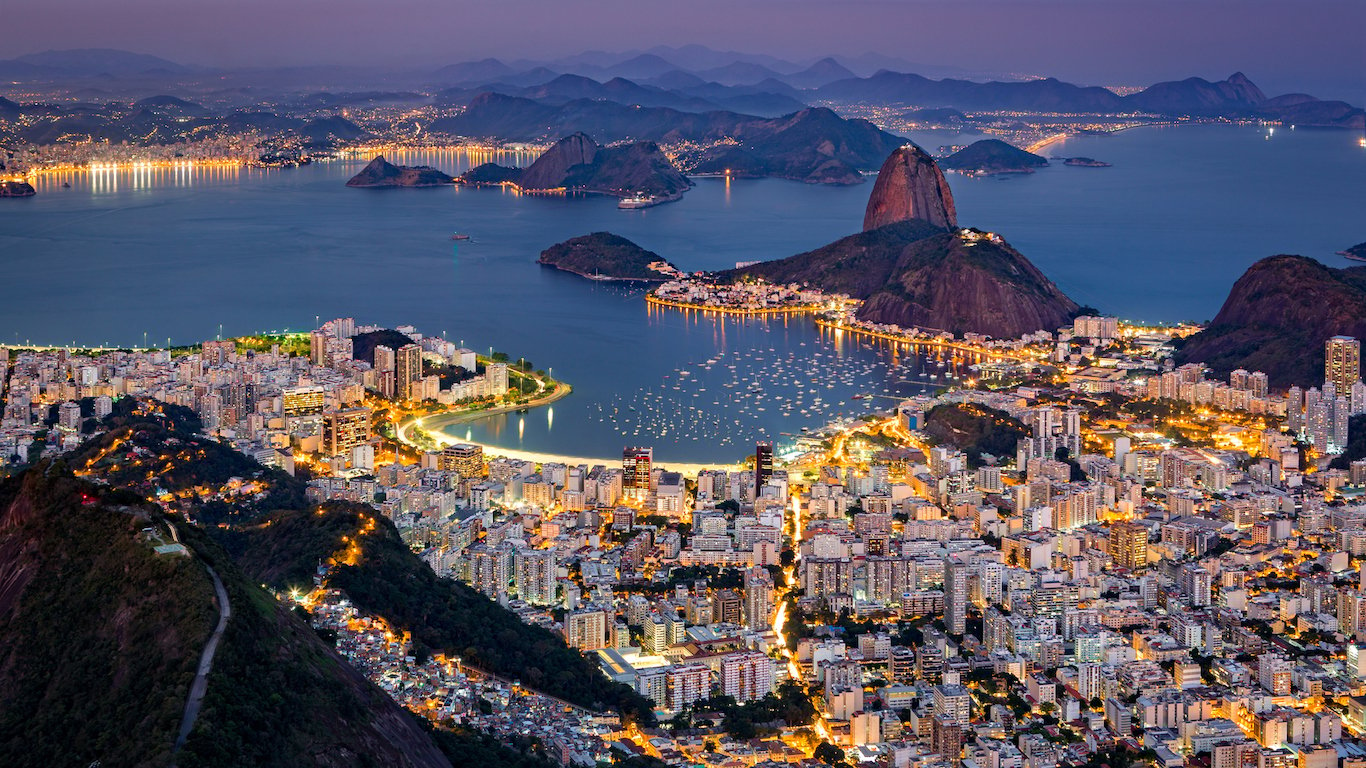

What is a city? Definitions vary, but it is generally agreed that, at minimum, it’s a permanent human settlement — something more than a nomadic encampment. Most would probably add that it must be sizable — though what that means would depend on the era — and be governed by laws. Some authorities maintain that it must also have a functioning sanitation system. It goes on from there.
Archeologists dispute the identity of the first agglomeration that could be called a city, but it was most probably in Mesopotamia, today’s Middle East. The strongest contender for the honor is the long-vanished Eridu, in modern-day Iraq, whose ruins were first excavated in 1855. The oldest continuously inhabited city, on the other hand, is most likely Damascus, which may date back as much as 11,000 years — though another Syrian city, Aleppo, also has a claim to the honor, as does Jericho, in the Palestinian Territories.
Jericho was said to have been the world’s largest city back around 7000 B.C. It had about 2,000 inhabitants at the time. By 500 A.D., Constantinople — modern-day Istanbul — was home to about half a million people (it’s now the fourth-largest city on the planet). By 900, another city on today’s largest list, Baghdad, had a population of about a million. Three hundred years later, the comparatively little-known Chinese city of Kaifeng surpassed a million. Today, 17 of the world’s 50 most populous cities are in China.
Some 33 of them are in Asia, in fact. A mere seven are in the Americas, along with four in Europe, three in the Middle East, and three in Africa.
Why do some cities grow more than others? The obvious physical reasons: liveable climate, abundant natural resources, accessibility (it’s no accident that most fast-growing cities in the pre-airplane age were situated on rivers or seacoasts), and room to expand geographically.
Social and political factors apply, too. The “bright lights, big city” factor has always drawn rural populations to town, for instance. So have employment opportunities, real or imagined — the real ones often spurred by government investment or tax incentives to help grow industry.
As the world’s population increases, inexorably — by about 83 million each year — so does the population of most cities. Some grow so rapidly that they leap-frog up the ladder, overshadowing municipalities that had been among the most populous. This list reflects where things stand today; in a year or two or five, the order might be different, and some new large cities might have joined the roster.
Click here to see the 50 largest cities in the world.
Click here to see the 25 tiny cities around the world.
24/7 Wall St. reviewed the largest cities in the world as ranked in March 2018 by The City Mayors Foundation, an international research think tank dedicated to urban affairs. The foundation’s research was conducted during 2017 and early 2018. The City Mayors estimates are based on various national and international sources. Country population figures are for 2018 and were obtained from the U.S. Census Bureau’s International Data Base (IDB).
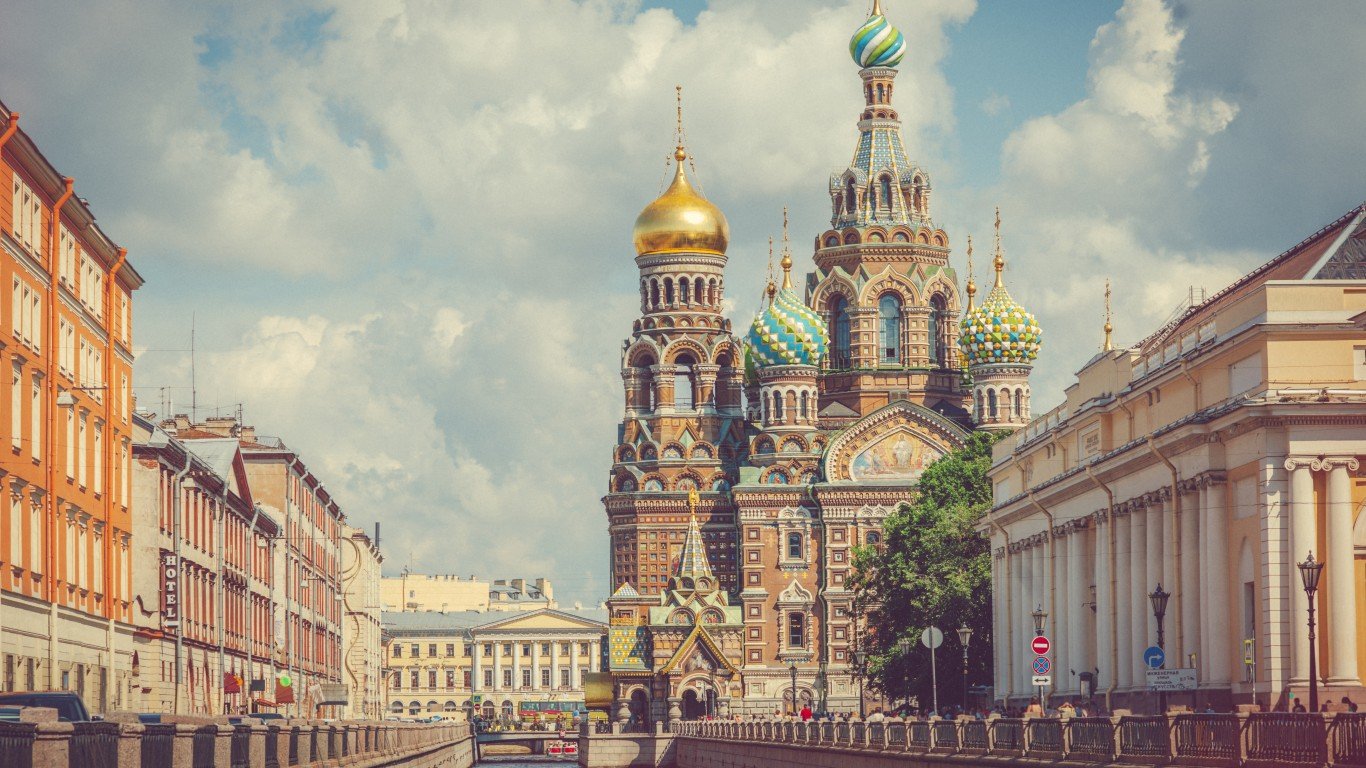
50. St Petersburg, Russia
> City population: 5,323,000
> Country population: 142,122,776
> Pct. of Russia’s population: 3.7%
Russia’s second largest city after Moscow, this cultural and business capital boasts an unemployment rate of only 1.1%. St Petersburg owes its population growth not only to newcomers from elsewhere in the country and abroad, but also to the fact that the city’s fertility rate has almost doubled over the past 20 years.
[in-text-ad]

49. Suzhou, China
> City population: 5,468,000
> Country population: 1,384,688,986
> Pct. of China’s population: 0.4%
An ancient city known for its network of canals, Suzhou was one of the world’s 10 largest cities in 100 A.D. and has long been one of the most prosperous. In the 19th century, it was also one of the largest non-capital cities in the world. The port of Suzhou boasted a 50% increase in cargo handled between 2011 and 2016, and the silk and cotton textile industries as well as a new technology park provide employment opportunities for migrants from elsewhere in China.
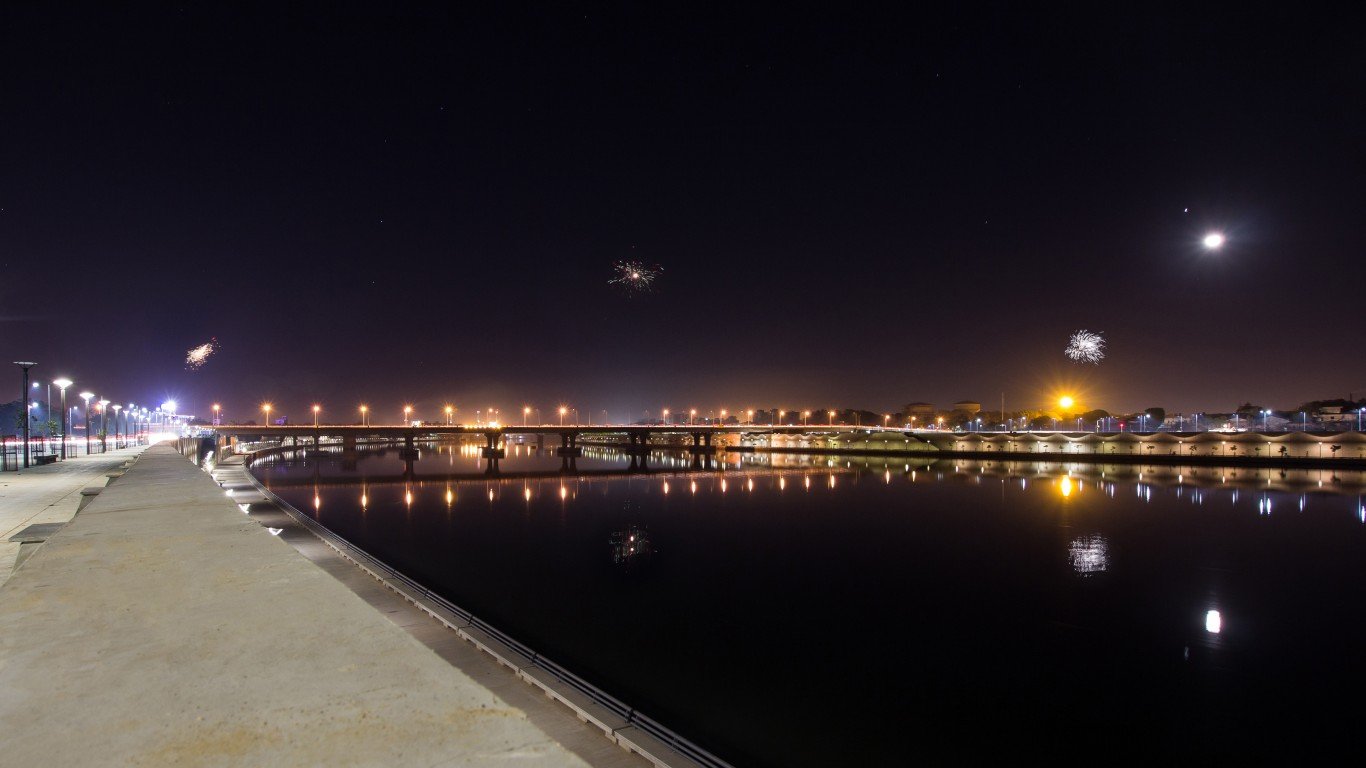
48. Ahmedabad, India
> City population: 5,577,000
> Country population: 1,296,834,042
> Pct. of India’s population: 0.4%
The sixth largest city in India and the former capital of the Gujarat region, Ahmedabad continues to grow. In the 40-year period between 1975 and 2015, the population of Ahmedabad’s metropolitan area grew rapidly to more than 6 million.
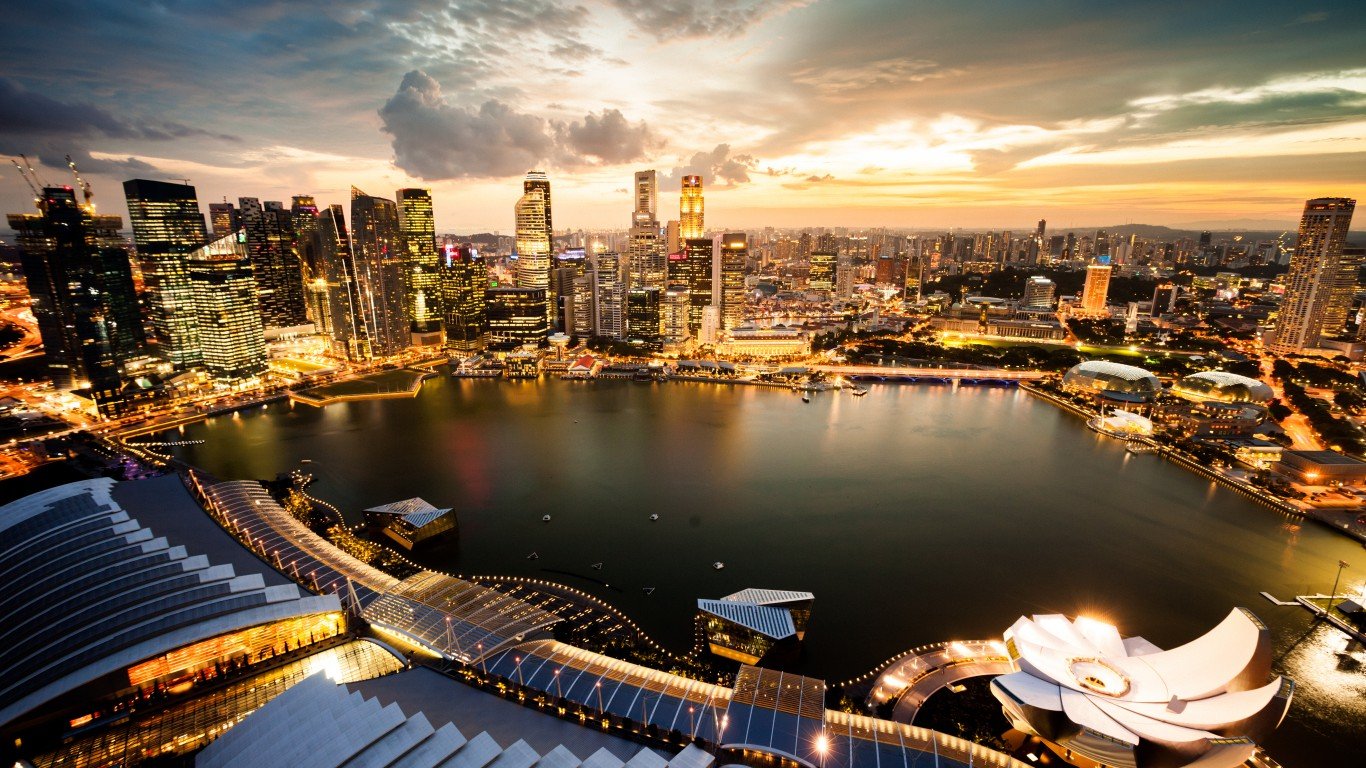
47. Singapore
> City population: 5,607,000
> Country population: 5,995,991
> Pct. of Singapore’s population: 93.5%
The population of this Asian city-state, which became an independent nation only in 1965, has almost tripled since its founding. This global financial center has one of the world’s highest life expectancies, and the government is attempting to increase population further by actively campaigning (thus far unsuccessfully) to approximately double the birth rate.
[in-text-ad-2]
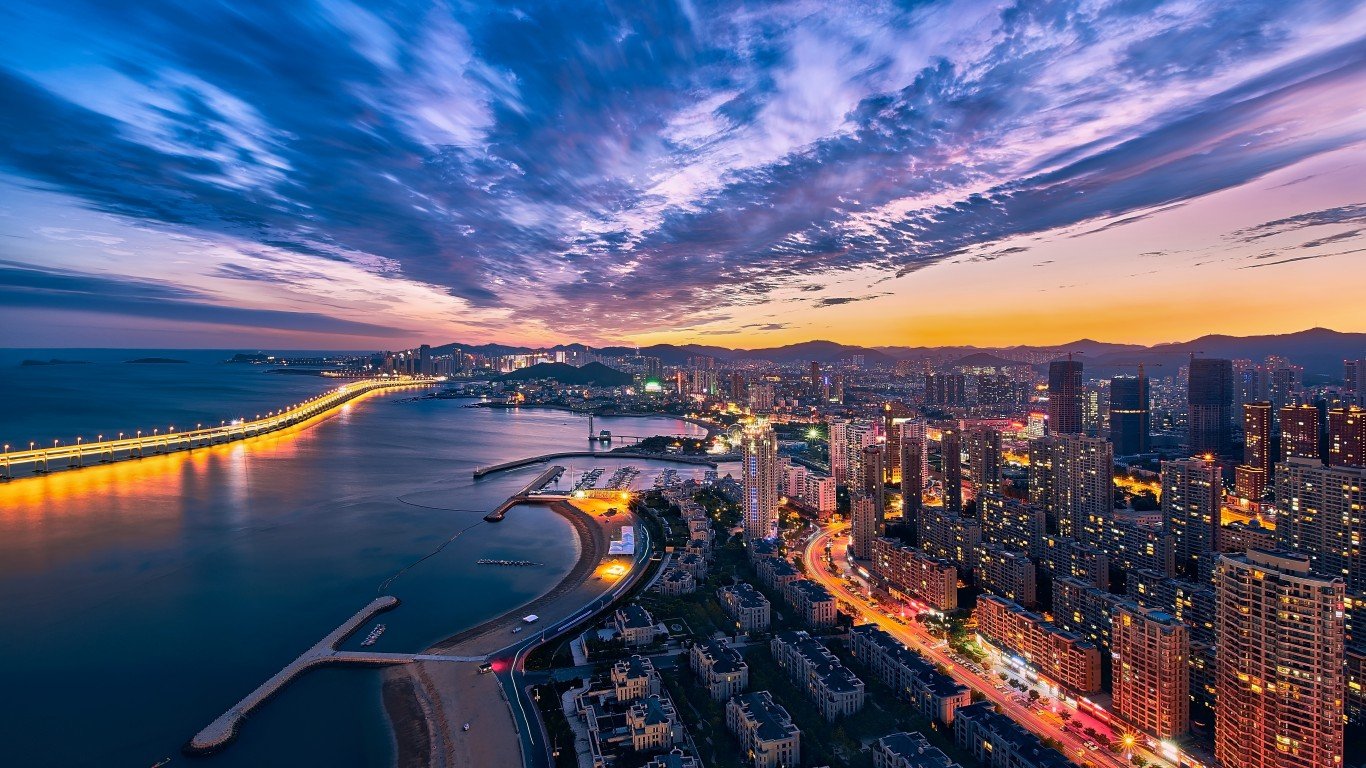
46. Dalian, China
> City population: 5,900,000
> Country population: 1,384,688,986
> Pct. of China’s population: 0.4%
A one-time fishing village that became Russian property in 1898 and was later under Soviet control before being returned to China in 1950, Dalian today is a major industrial center as well as an important port. Its population has more than tripled since 1990, and in 2013 it was identified as China’s most congested city by the Chinese Academy of Social Services.
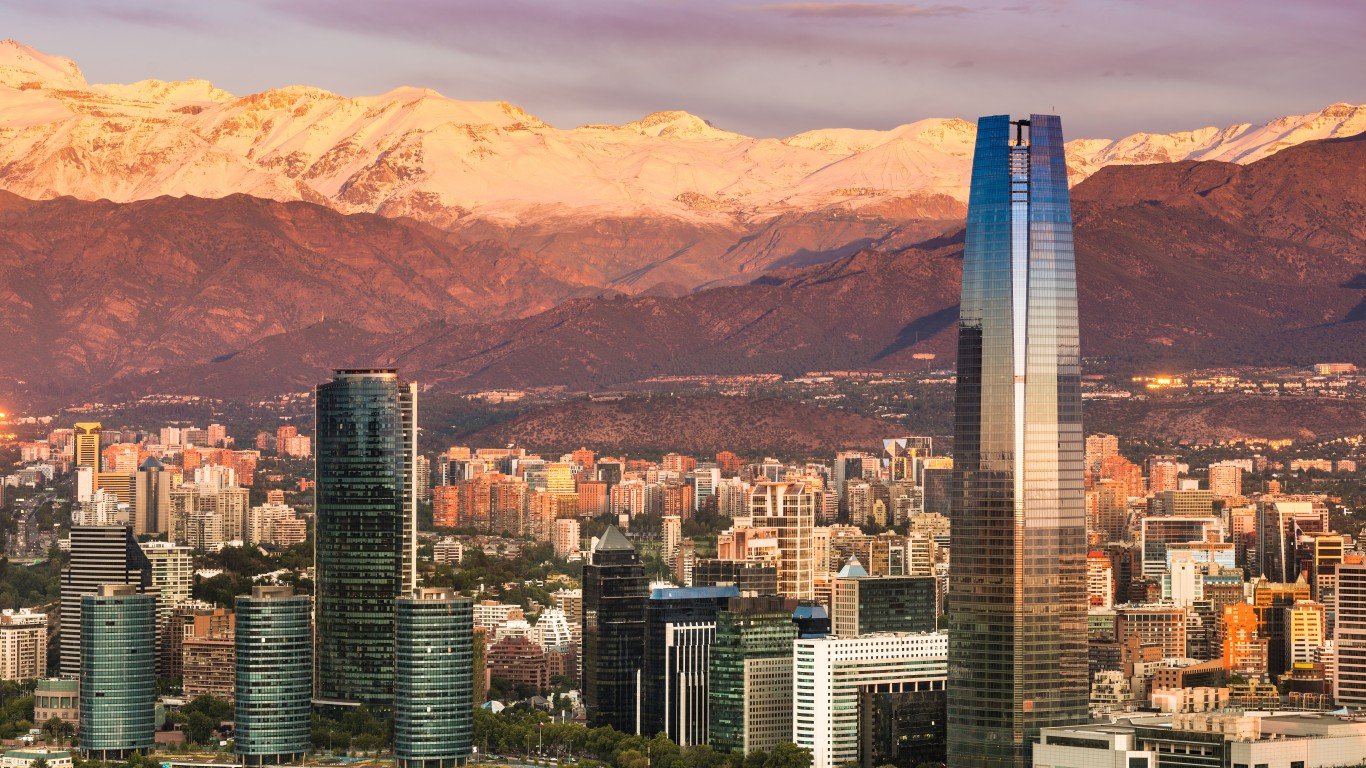
45. Santiago, Chile
> City population: 6,158,000
> Country population: 17,925,262
> Pct. of Chile’s population: 34.4%
While the population of this massive South American capital accounts for about a third of Chile’s total population, Santiago’s city center holds only about 200,000 residents. Together with the surrounding neighborhoods and near suburbs, however, the city has a population density of almost 25,000 people per square mile.
[in-text-ad]
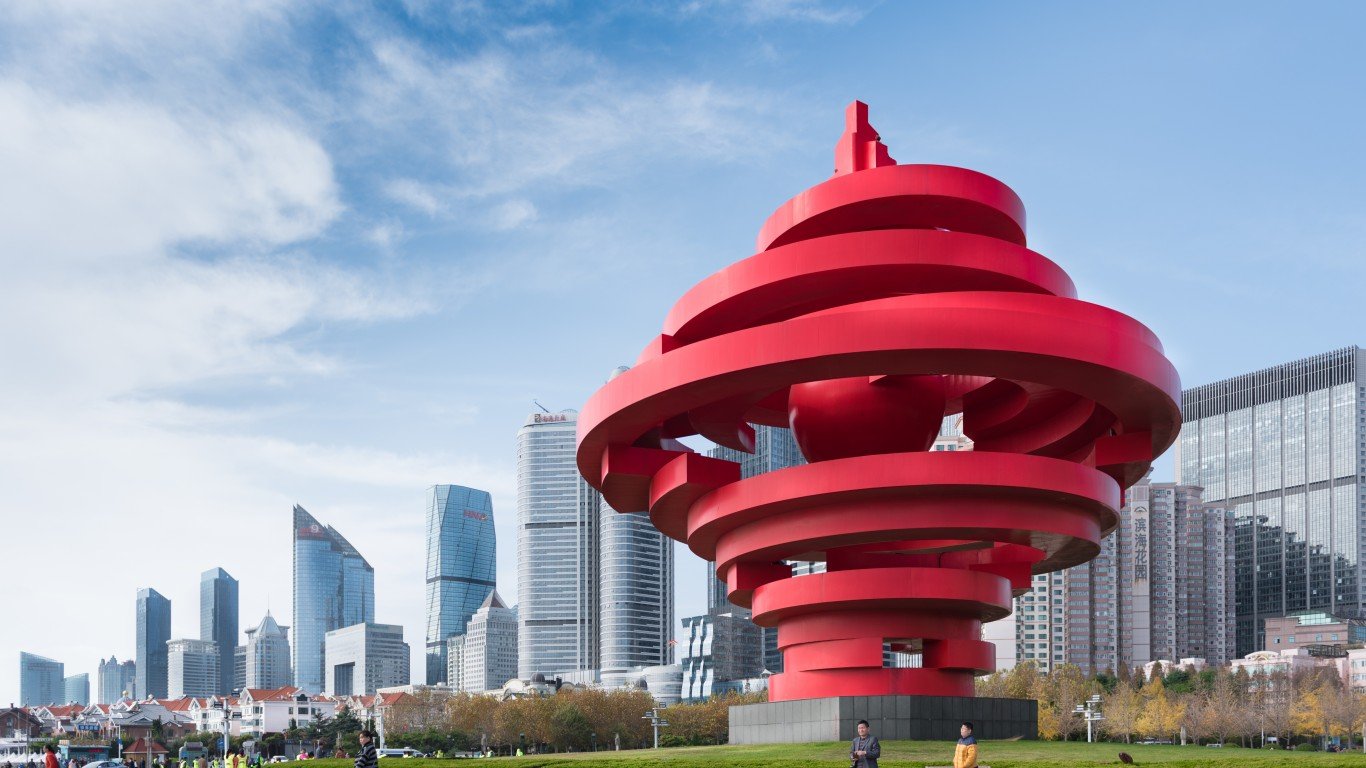
44. Qingdao, China
> City population: 6,188,000
> Country population: 1,384,688,986
> Pct. of China’s population: 0.4%
Qingdao is known as “China’s Sailing City” for having hosted the 2008 Summer Olympics nautical competitions and a number of subsequent boat racing events. With its comparatively high standard of living and vibrant export economy, the city attracts many newcomers. Qingdao is the headquarters of the consumer electronics and home appliance group Haier and of Tsingtao Brewery, among other major companies.
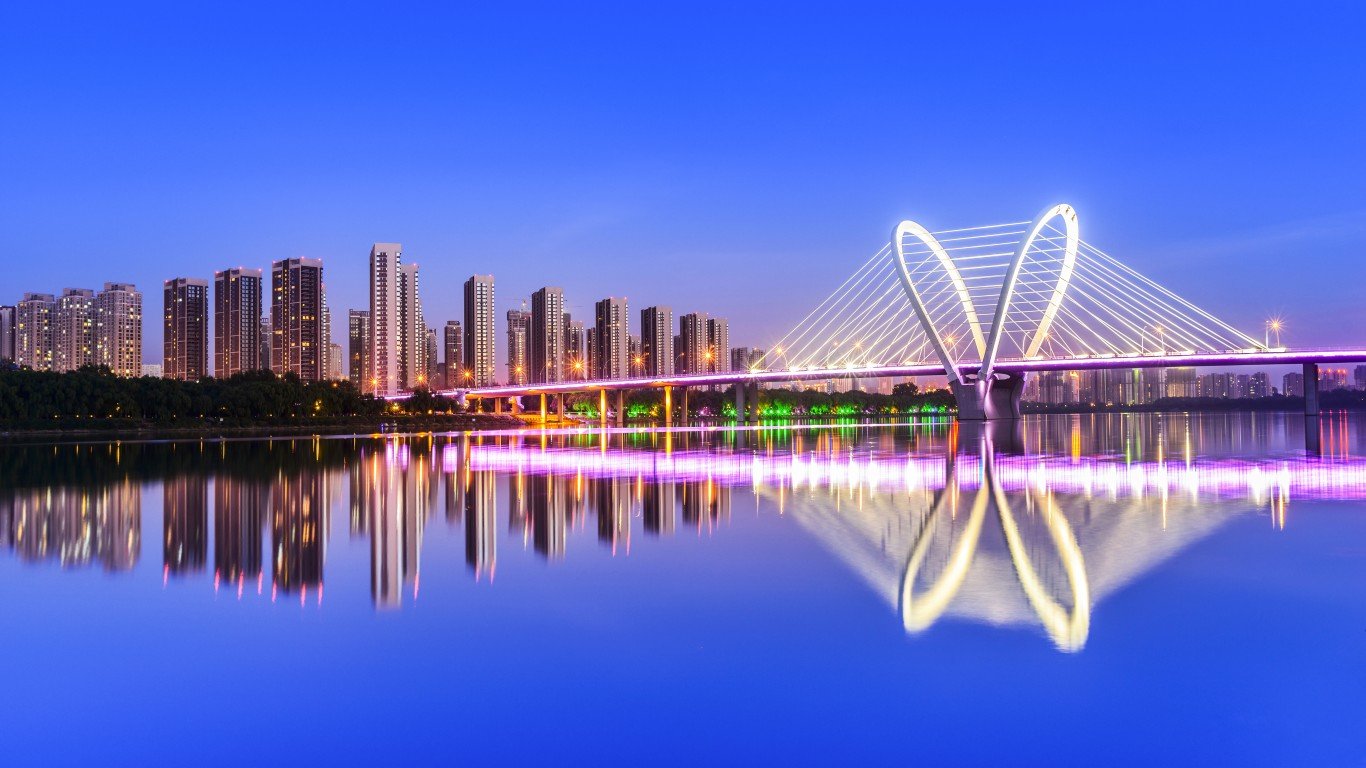
43. Shenyang, China
> City population: 6,255,000
> Country population: 1,384,688,986
> Pct. of China’s population: 0.5%
Though it’s a major industrial city, Shenyang was identified in a 2016 United Nations development report as China’s fourth most sustainably developed city. Shenyang is located near substantial coal and mineral deposits. It is also home to major aerospace and automotive concerns. The city’s population has doubled since 1970, and is projected to reach about 8 million by 2030.
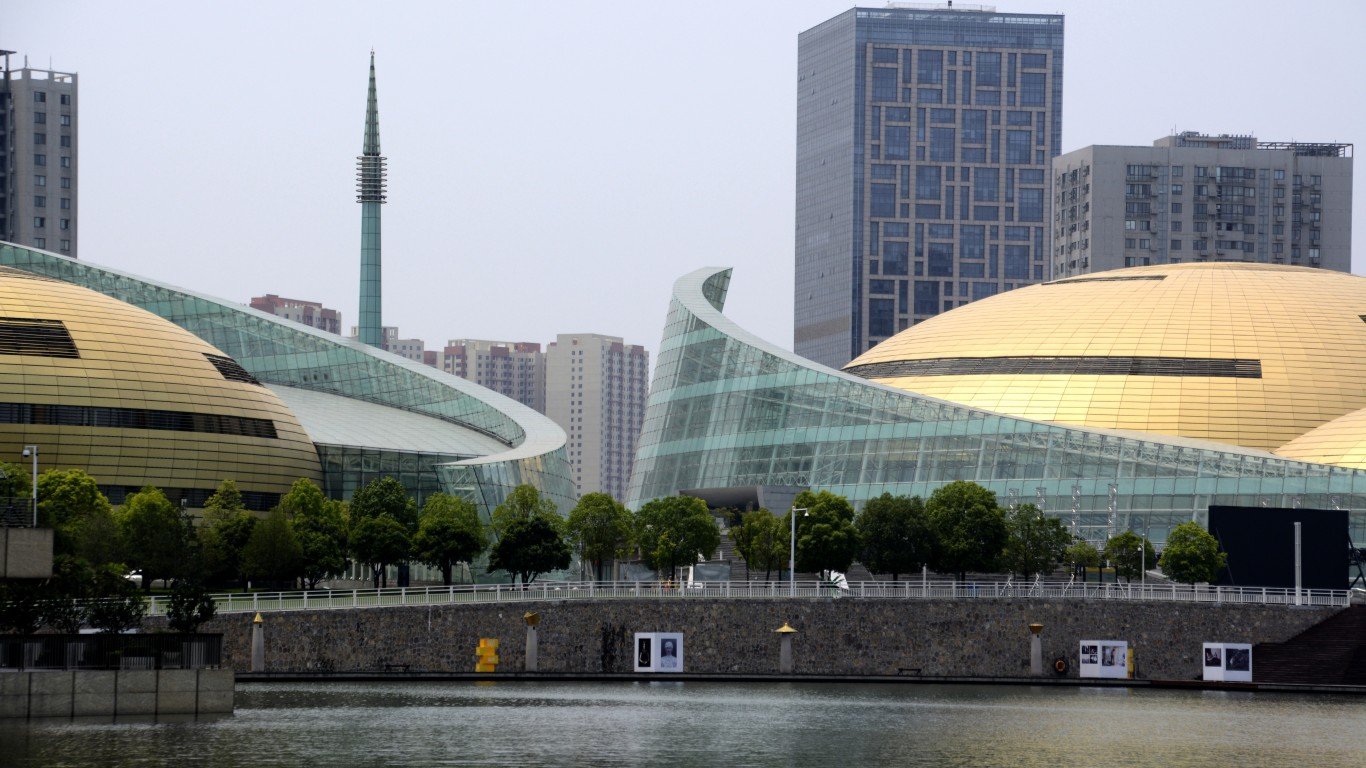
42. Zhengzhou, China
> City population: 6,406,000
> Country population: 1,384,688,986
> Pct. of China’s population: 0.5%
This major manufacturing center — home to the controversial Foxconn plant where 80% of the world’s iPhones are made — is also a major producer of frozen foods, automobiles, and heavy machinery. Zhengzhou’s population actually declined after 2010, and it was termed China’s largest “ghost city” for its many unoccupied buildings. The city began rebounding in 2012 and is now considered an emerging mega-city.
[in-text-ad-2]
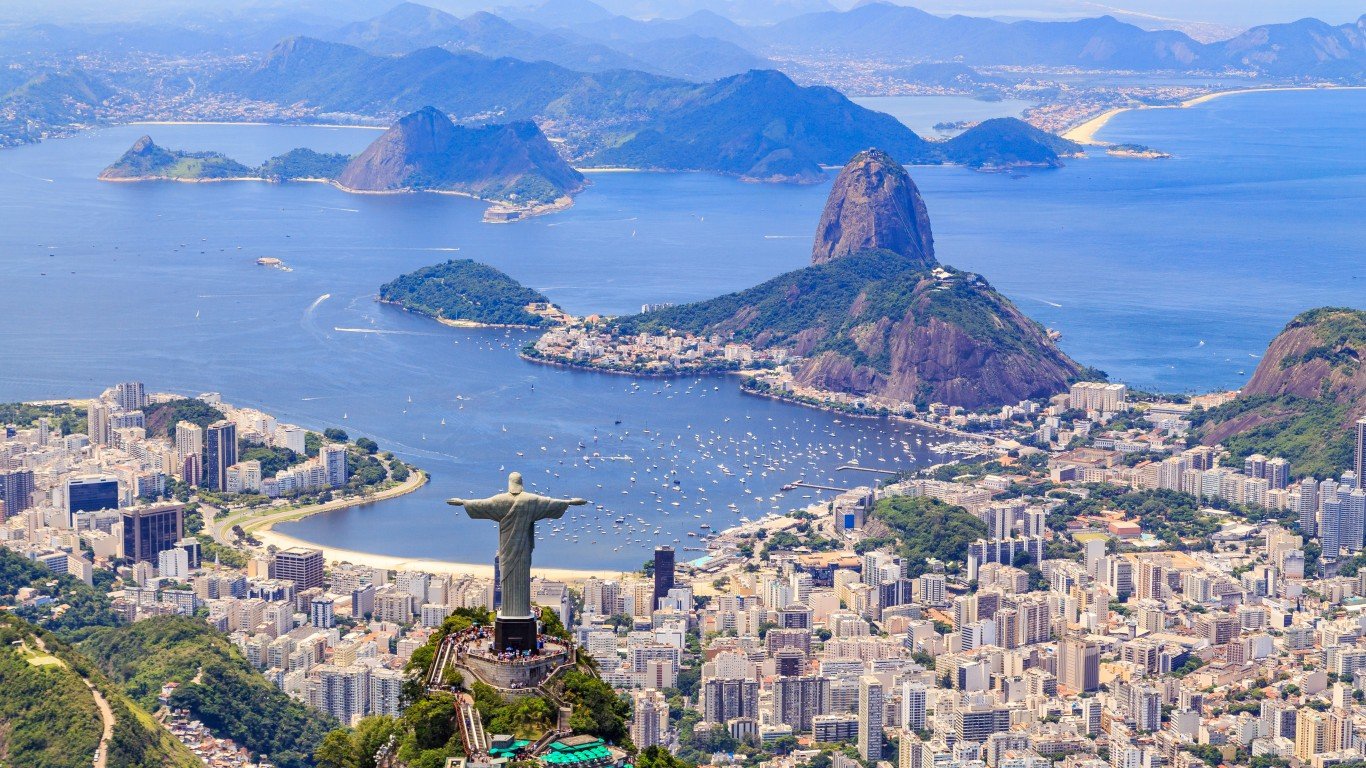
41. Rio de Janeiro, Brazil
> City population: 6,454,000
> Country population: 208,846,892
> Pct. of Brazil’s population: 3.1%
Brazil’s second-largest city, Rio, which hosted the 2016 Summer Olympics, is a popular tourist destination with a fast-growing multi-ethnic population. The city lost its long-held position as the country’s capital in 1960 (in favor of the newly built city of Brasilia), but its population grew by 115.3% over the next 40 years and, since Rio is the country’s major tourism destination and the center of its petroleum industry, it continues to increase.
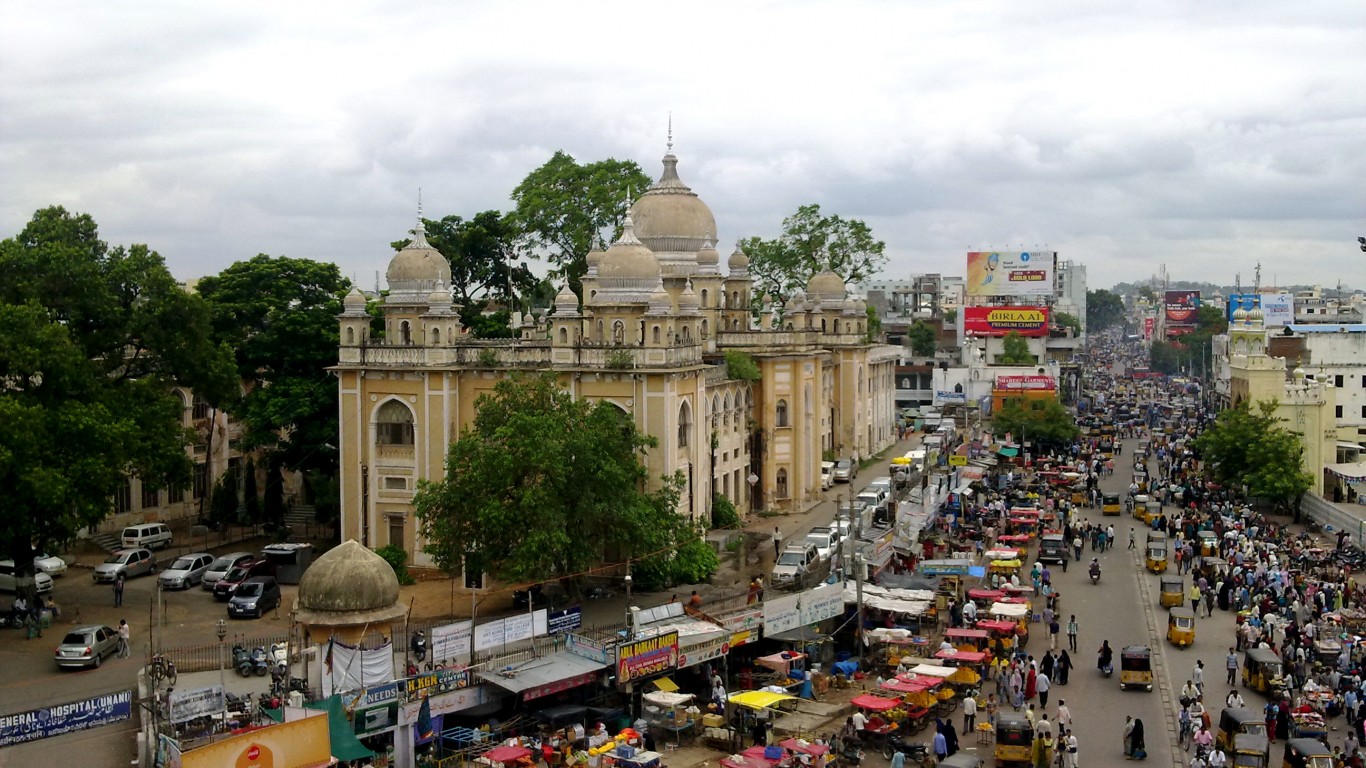
40. Hyderabad, India
> City population: 6,809,000
> Country population: 1,296,834,042
> Pct. of India’s population: 0.5%
Hyderabad is one of India’s fastest growing cities, thanks primarily to substantial migration from poorer rural areas. A 2011 census revealed that almost a quarter of the city’s population had come from other parts of the country. The population growth has overwhelmed the city due to inadequate housing and employment opportunities. Some 13% of residents live below the poverty line, and about 1.7 million Hyderabad residents live in slums.
[in-text-ad]
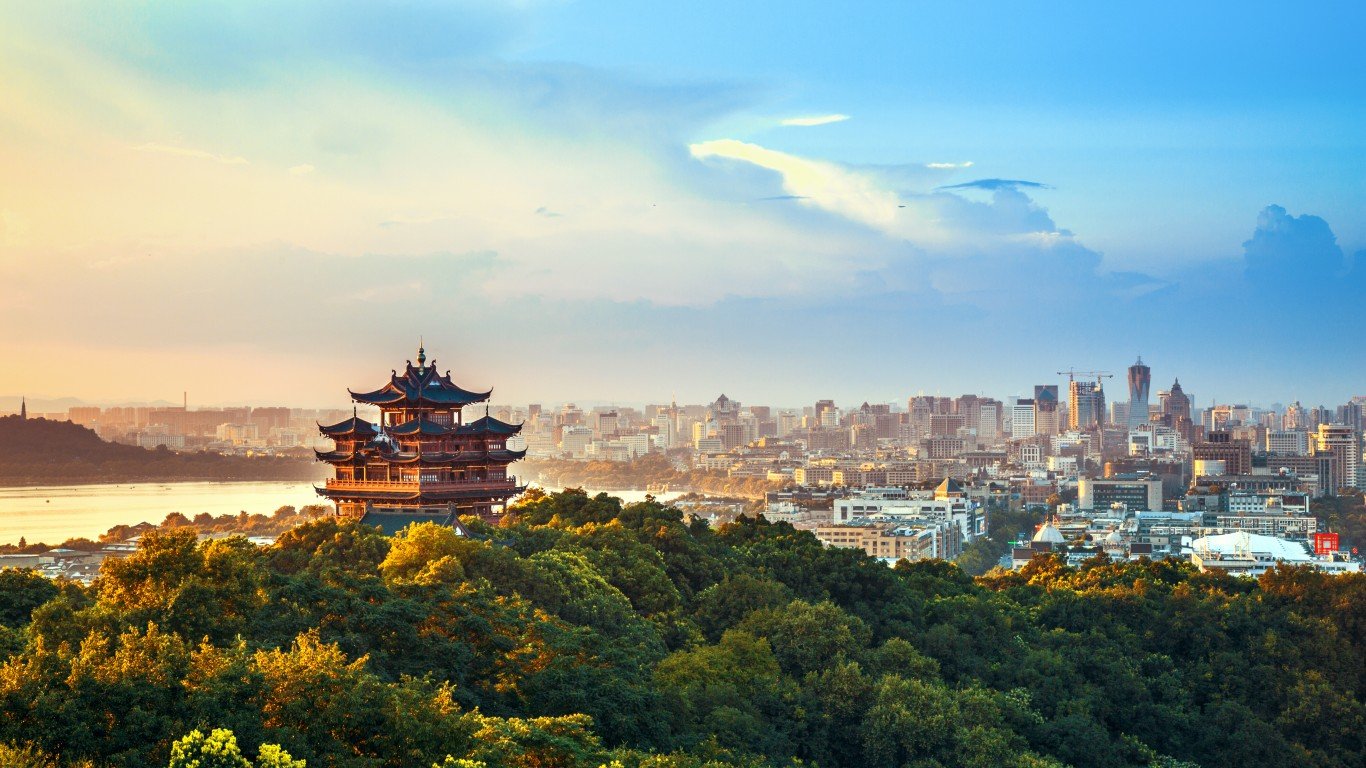
39. Hangzhou, China
> City population: 7,082,000
> Country population: 1,384,688,986
> Pct. of China’s population: 0.5%
Popular with tourists as the site of West Lake, a UNESCO World Heritage Site, as well as for its festivals and monument- and museum-rich cultural districts, Hangzhou has always been a major city. In its “golden age,” from 1180 to 1300 A.D., its population reached as high as 1.5 million. Today, the city continues to grow, drawing workers from other parts of China for its financial services, e-commerce, software, and other industries.

38. Chennai, India
> City population: 7,088,000
> Country population: 1,296,834,042
> Pct. of India’s population: 0.5%
Formerly known as Madras, Chennai, India’s fourth largest city, is considered “the Detroit of India” for its automotive industry. In 2011, the city’s area was expanded from 176 square kilometers (about 68 square miles) to 426 square kilometers (about 164.5 square miles), greatly increasing its official population.
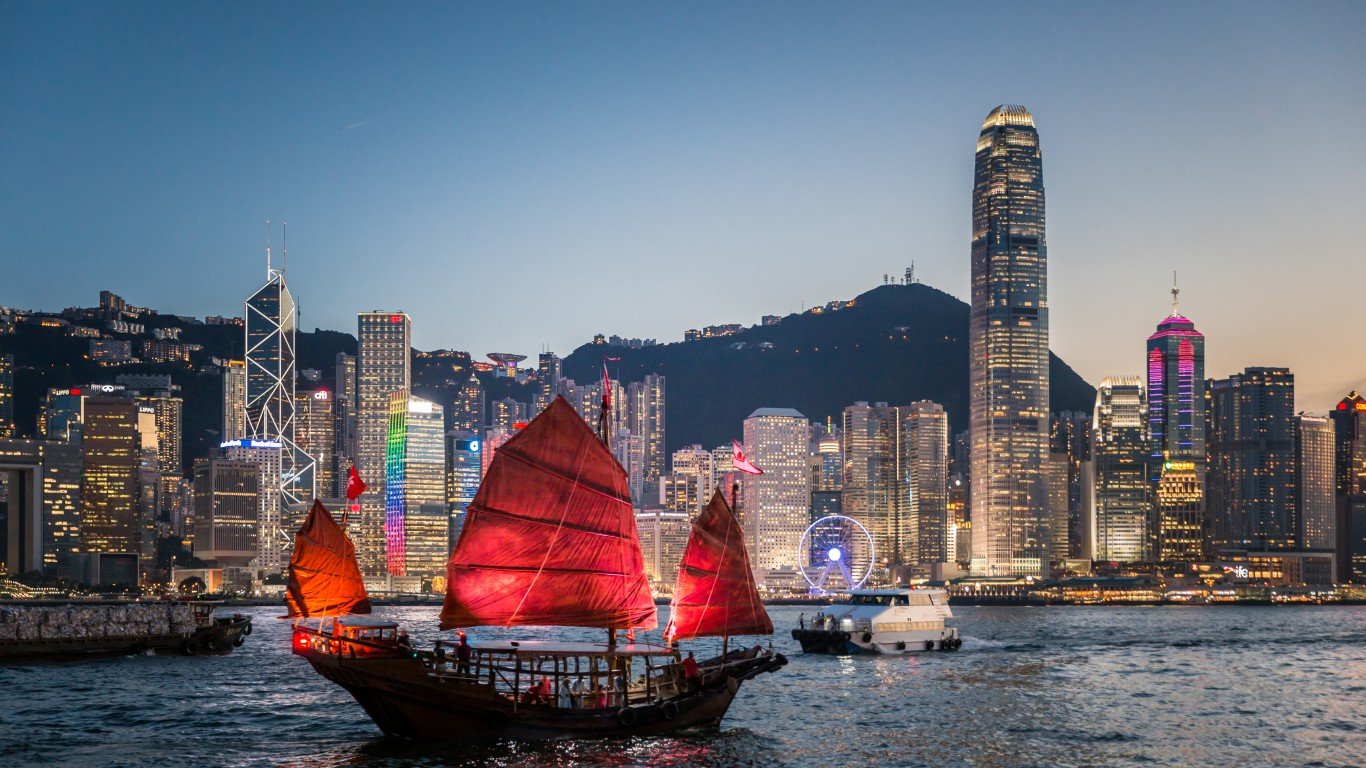
37. Hong Kong, China
> City population: 7,234,800
> Country population: 1,384,688,986
> Pct. of China’s population: 0.5%
Hong Kong is an anomaly. Like Macau, it is a Special Administrative Region of China — not an independent country (though it functions like one in some ways), but more than a city (though it is commonly considered one). It is one of the most densely populated places in the world, with more than 6,700 people per square mile. In comparison, the rest of China’s population density per square mile is 142, and the U.S.’s is 84. When the British took possession of Hong Kong in 1841, its population was 7,541. A century later, it had reached 1.6 million. At the time of the transfer of power from Great Britain to China in 1997, when it had become a major global financial center, the number stood at 6.5 million. Though life expectancy here is long, the fertility rate is low, and the population growth rate has slowed considerably in recent years.
[in-text-ad-2]
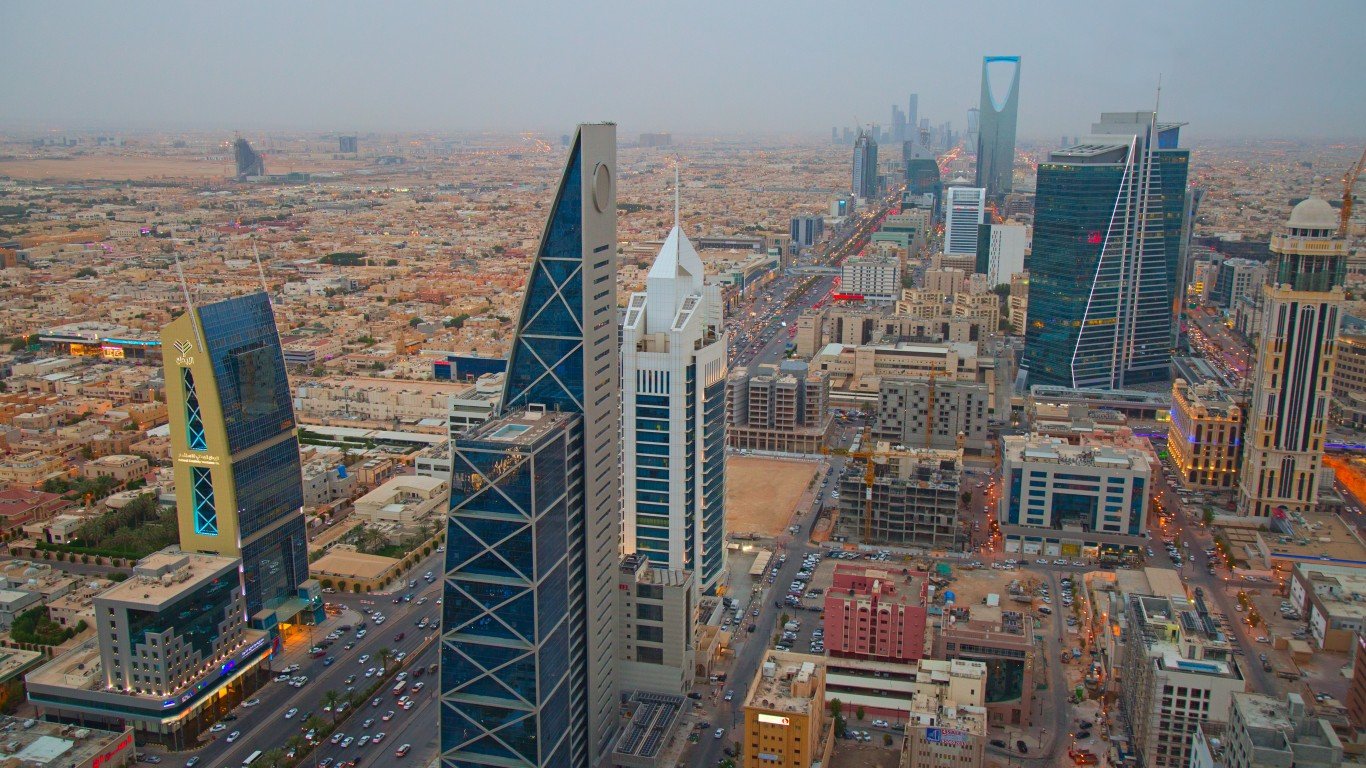
36. Riyadh, Saudi Arabia
> City population: 7,506,000
> Country population: 28,985,905
> Pct. of Saudi Arabia’s population: 25.9%
The capital and main population center of Saudi Arabia, Riyadh hasn’t had an official census since 2010, but at that time, about 30% of the population was non-Saudi. In 1950, there were only 111,000 residents in the city. The highest periods of population increase extended between 1965 and 1990, though the growth rate has abated considerably since then.
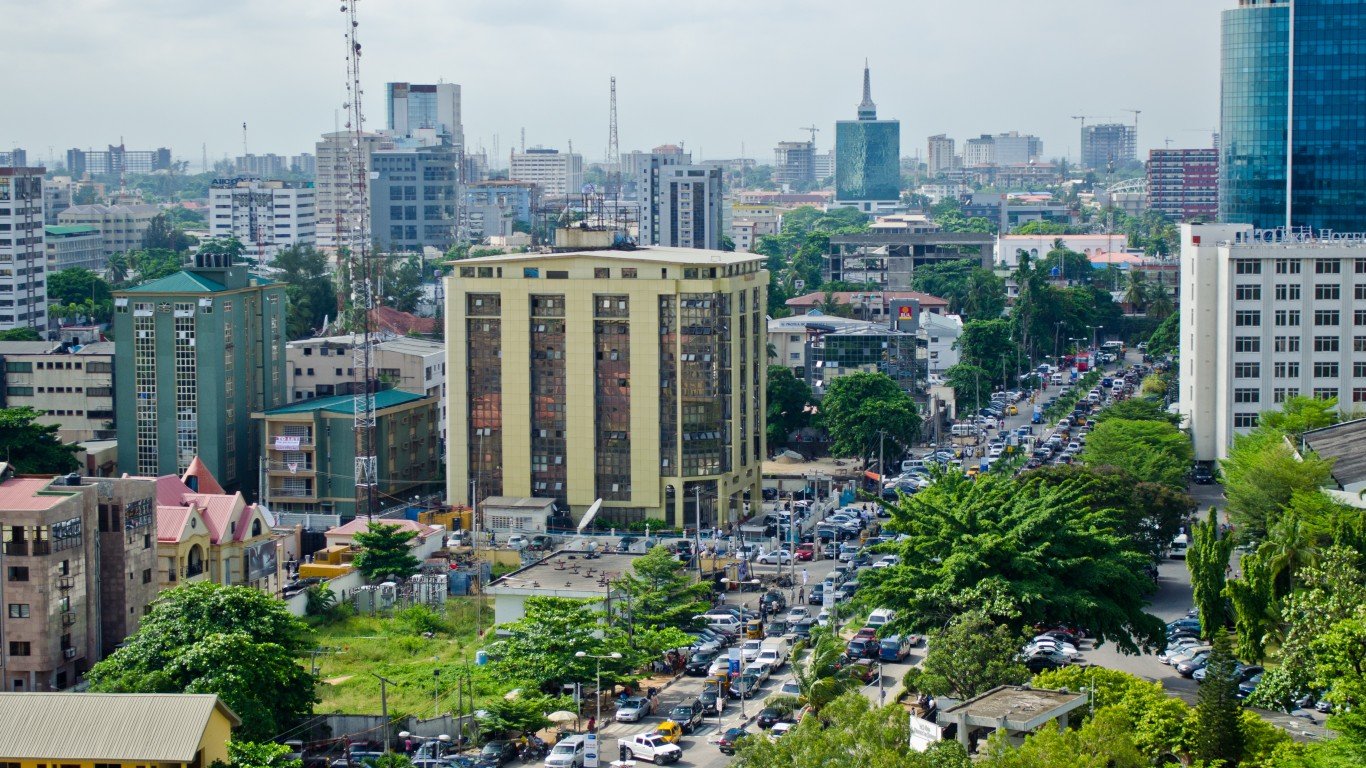
35. Lagos, Nigeria
> City population: 8,048,000
> Country population: 195,300,343
> Pct. of Nigeria’s population: 4.1%
The Nigerian capital and a major seaport, Lagos is by some estimates the most populous city in Africa, though other sources place it behind Cairo and Kinshasa. In any case, growth is so vigorous that projections suggest the population may double by 2050, which will almost certainly elevate it to the position of being one of the four or five largest cities in the world. More than 250 ethnic groups are said to reside in the city, including Asians, Europeans, and Americans as well as various African tribes.
[in-text-ad]
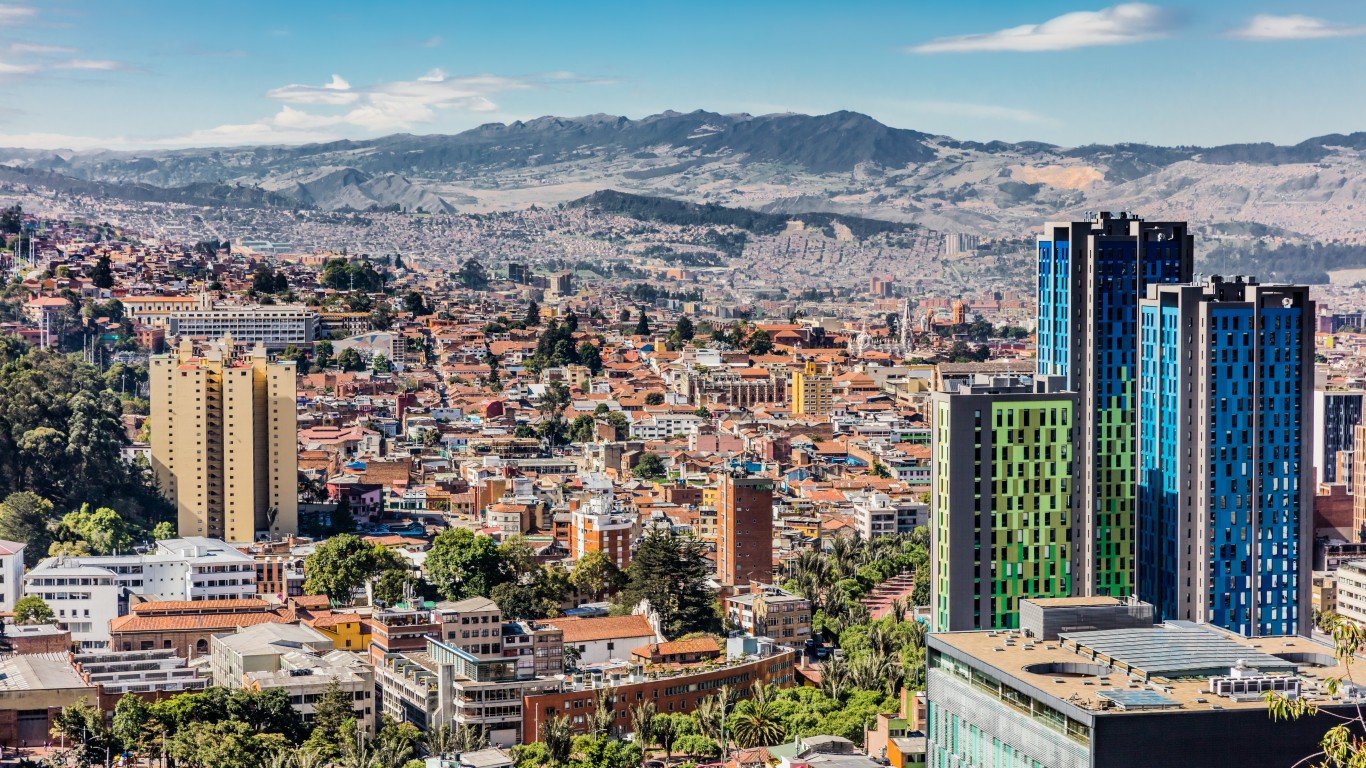
34. Bogotá, Colombia
> City population: 8,081,000
> Country population: 48,168,996
> Pct. of Colombia’s population: 16.8%
The establishment of the Archdiocese of Bogotá by the Catholic Church in the mid-16th century turned the city into an important religious and educational center. Immigration from other parts of Colombia is credited with helping the city grow from a population of 22,000 in 1800 to its present total. It is Colombia’s capital and the third largest city in South America.
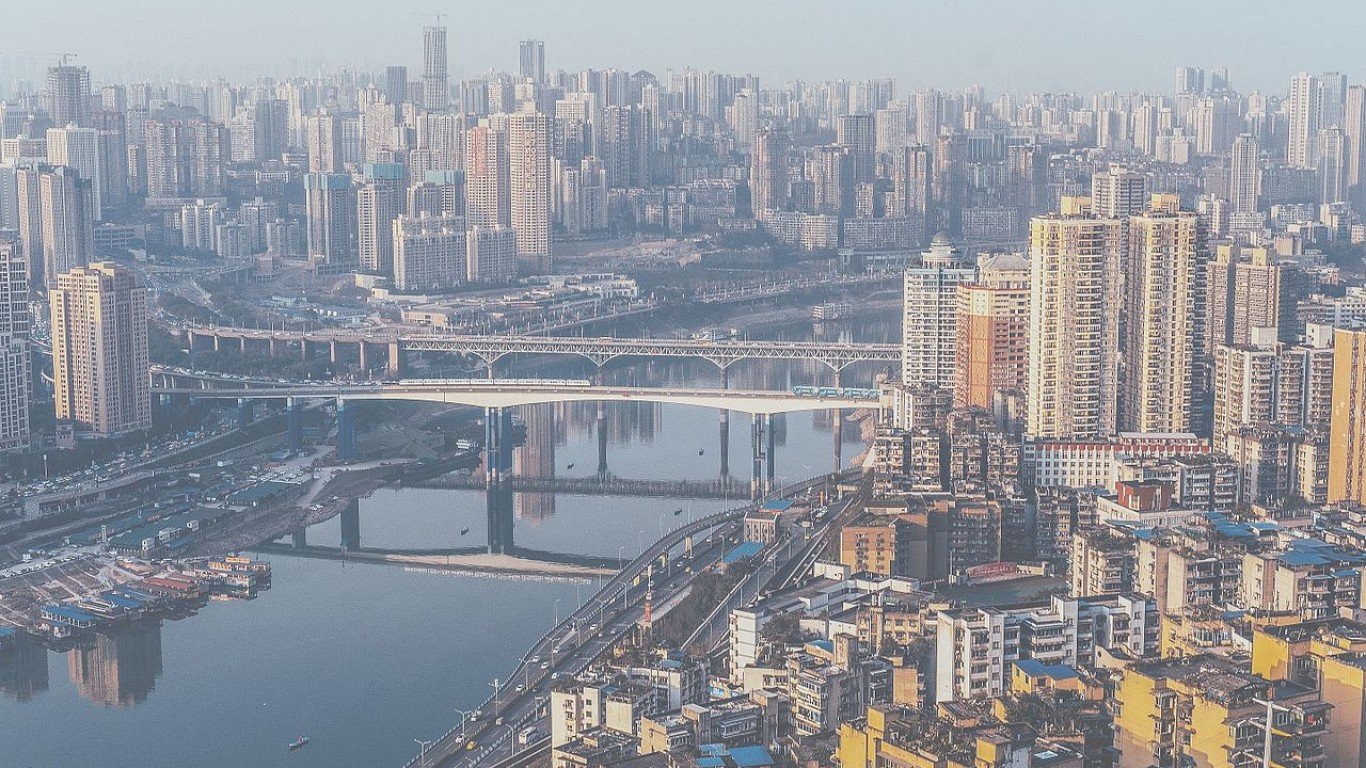
33. Chongquin, China
> City population: 8,165,500
> Country population: 1,384,688,986
> Pct. of China’s population: 0.6%
The largest city in southwestern China, this Yangtze River port was once the capital of Nationalist China. Chongquin became the country’s fourth provincial-level municipality after Beijing, Shanghai, and Tianjin, in 1997. This involved the incorporation of the eastern portion of neighboring Sichuan province into the municipality, which vastly expanded both its area and its population.
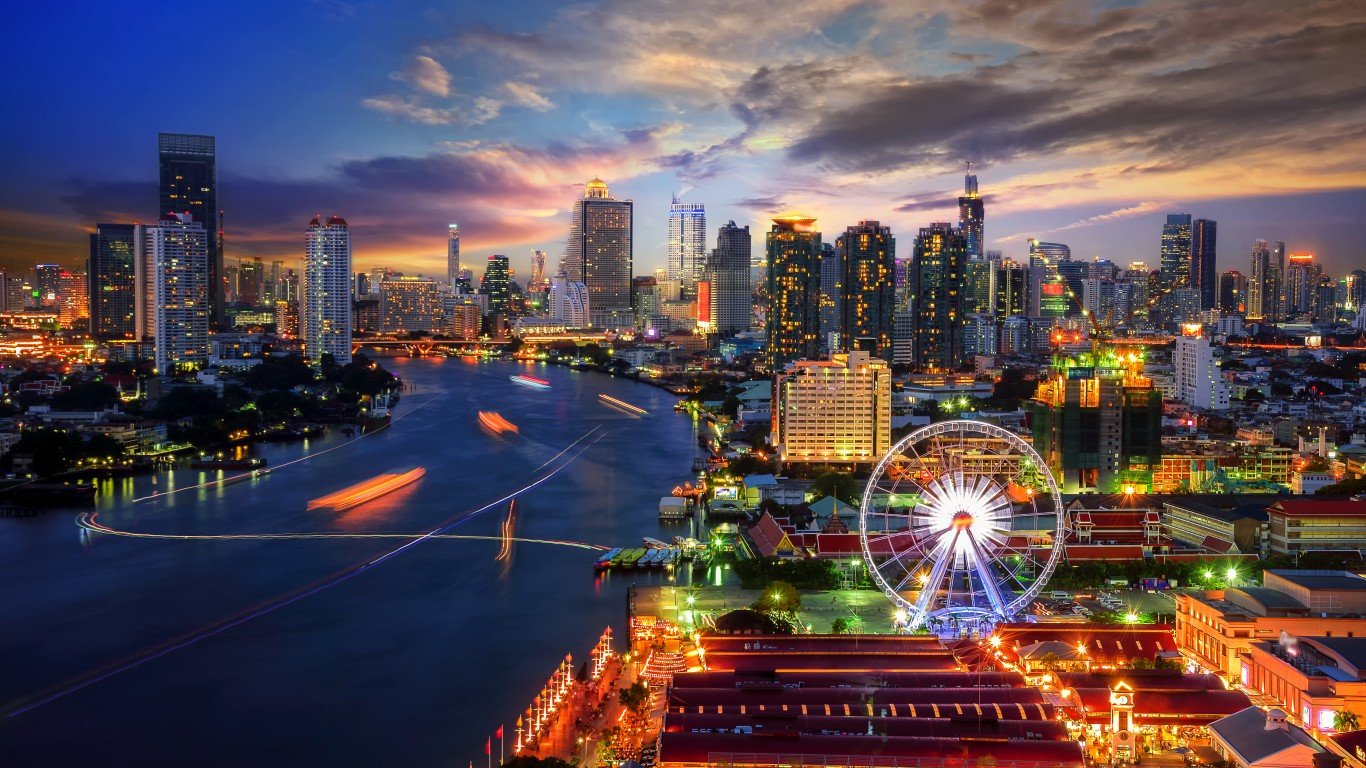
32. Bangkok, Thailand
> City population: 8,281,000
> Country population: 68,615,858
> Pct. of Thailand’s population: 12.1%
Though it became the capital of what was then known as Siam in 1782, Bangkok — called Krung Thep Mahanakhon in Thai — grew slowly until the mid-19th century. After that, the population increased so rapidly that the city’s infrastructure was overwhelmed, and today it suffers from severe air pollution and constant traffic jams. Though many ethnic groups call the city home, the Chinese are particularly numerous, and the city boasts one of the world’s largest Chinatowns.
[in-text-ad-2]
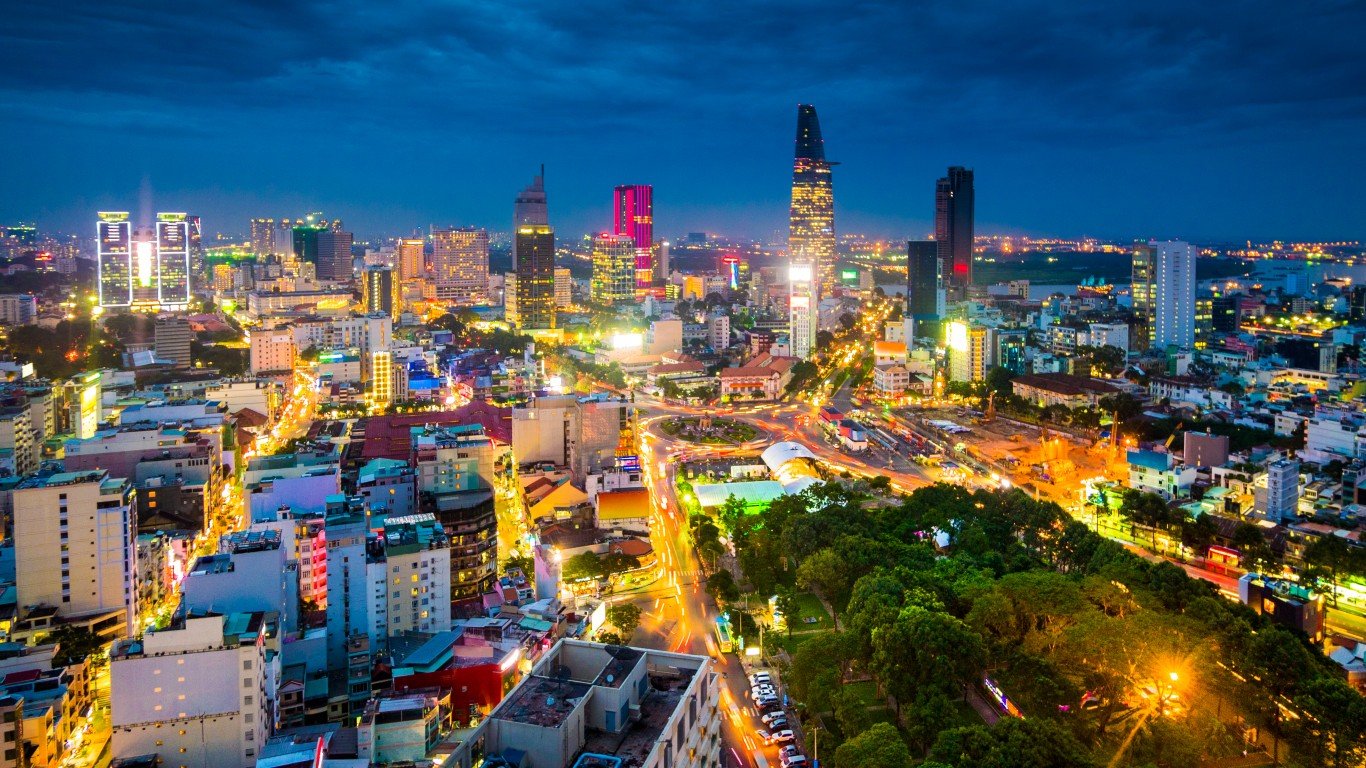
31. Ho Chi Minh City, Vietnam
> City population: 8,426,000
> Country population: 97,040,334
> Pct. of Vietnam’s population: 8.7%
Formerly known as Saigon (and still often called that, especially by expatriates), Ho Chi Minh City has a larger population than the Vietnamese capital, Hanoi. There hasn’t been a census in the city since 2009, but according to estimates at the time the population density was 9,264 people per square mile. Motorbikes are the preferred method of transportation, and there are said to be some 7.6 million of them in the city, approaching the number of total residents.
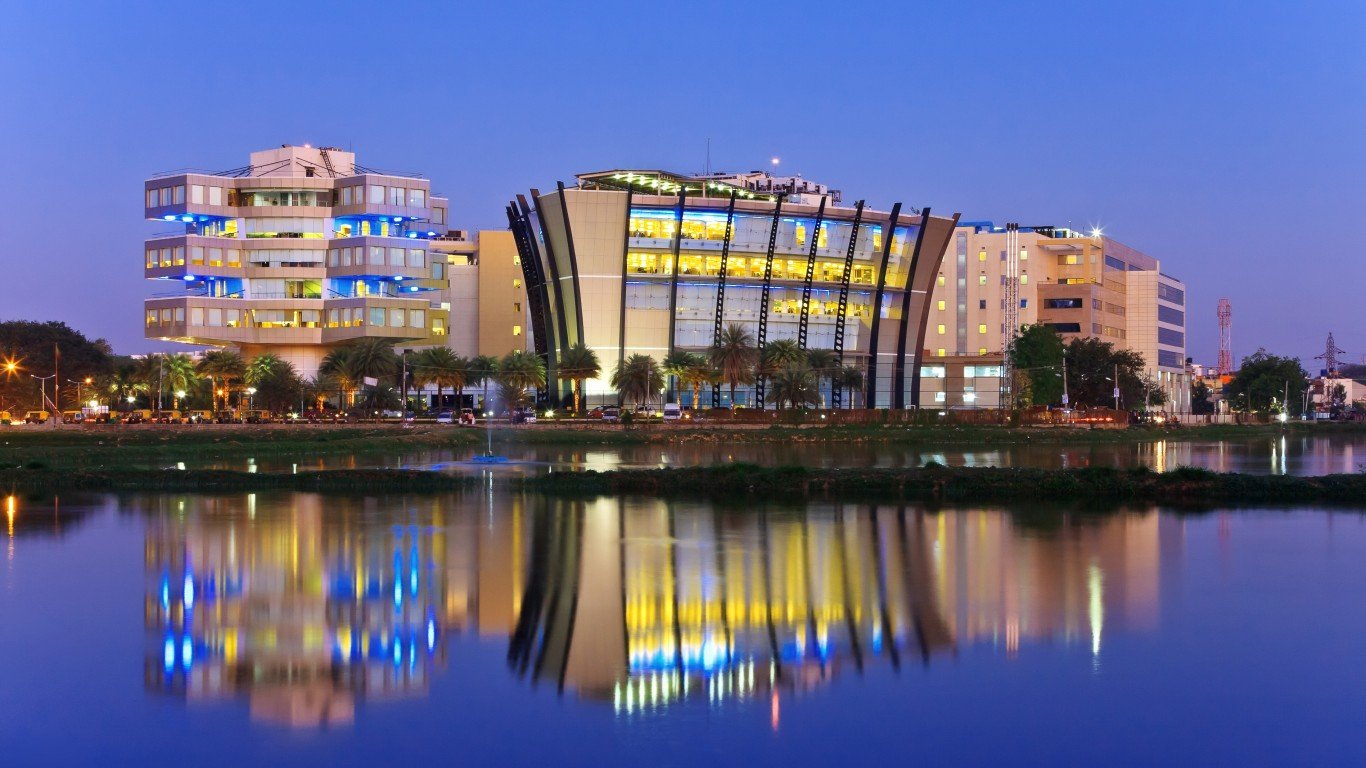
30. Bangalore, India
> City population: 8,444,000
> Country population: 1,296,834,042
> Pct. of India’s population: 0.7%
Bangalore, or Bengaluru, the so-called Silicon Valley of India, has seen its population density increase 47% in the past decade. Most of the new residents come from other parts of the country, drawn by job opportunities. Today, it is India’s third most populous city.
[in-text-ad]
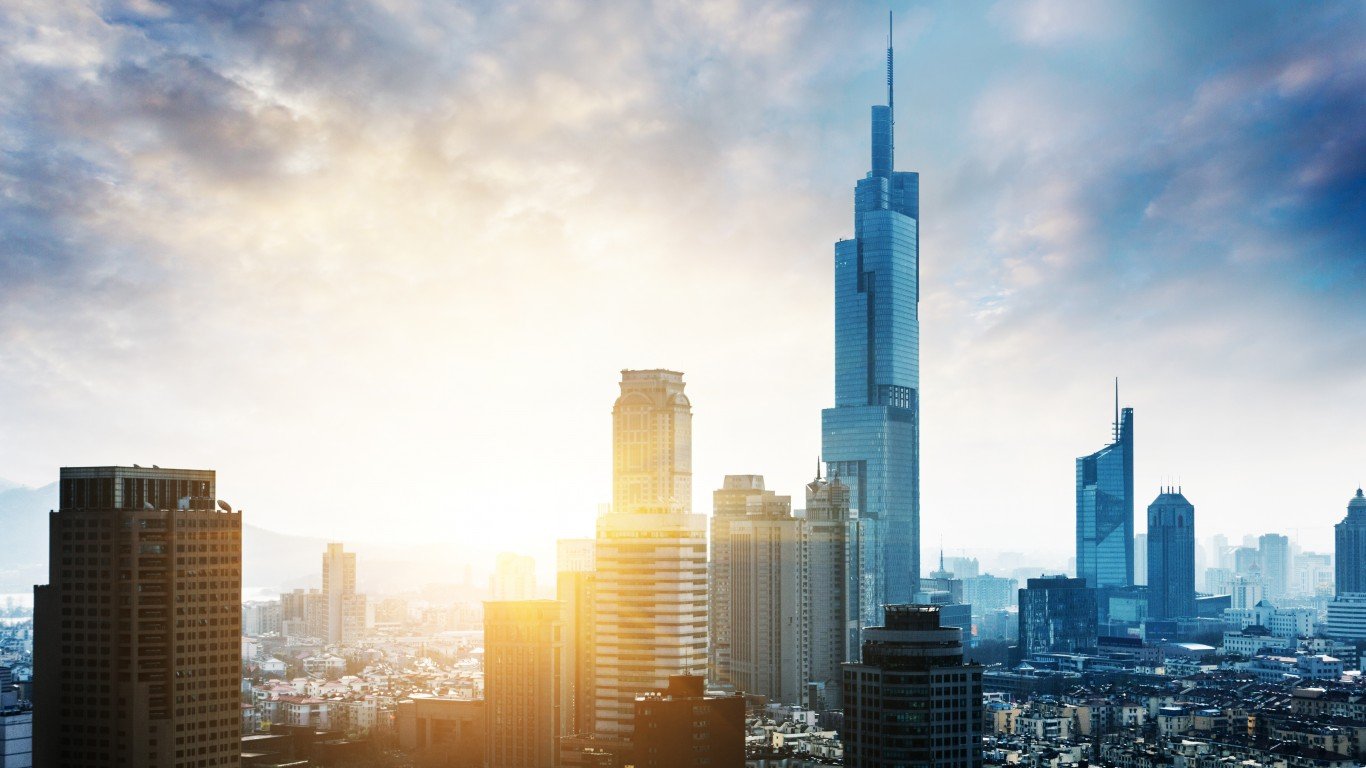
29. Nanjing, China
> City population: 8,460,000
> Country population: 1,384,688,986
> Pct. of China’s population: 0.6%
A major commercial, agricultural, and industrial center and Yangtze River port, Nanjing has been the capital of China twice in the nation’s history and today is the capital of Jiangsu province. The city’s population has more than quadrupled since the 1980s.
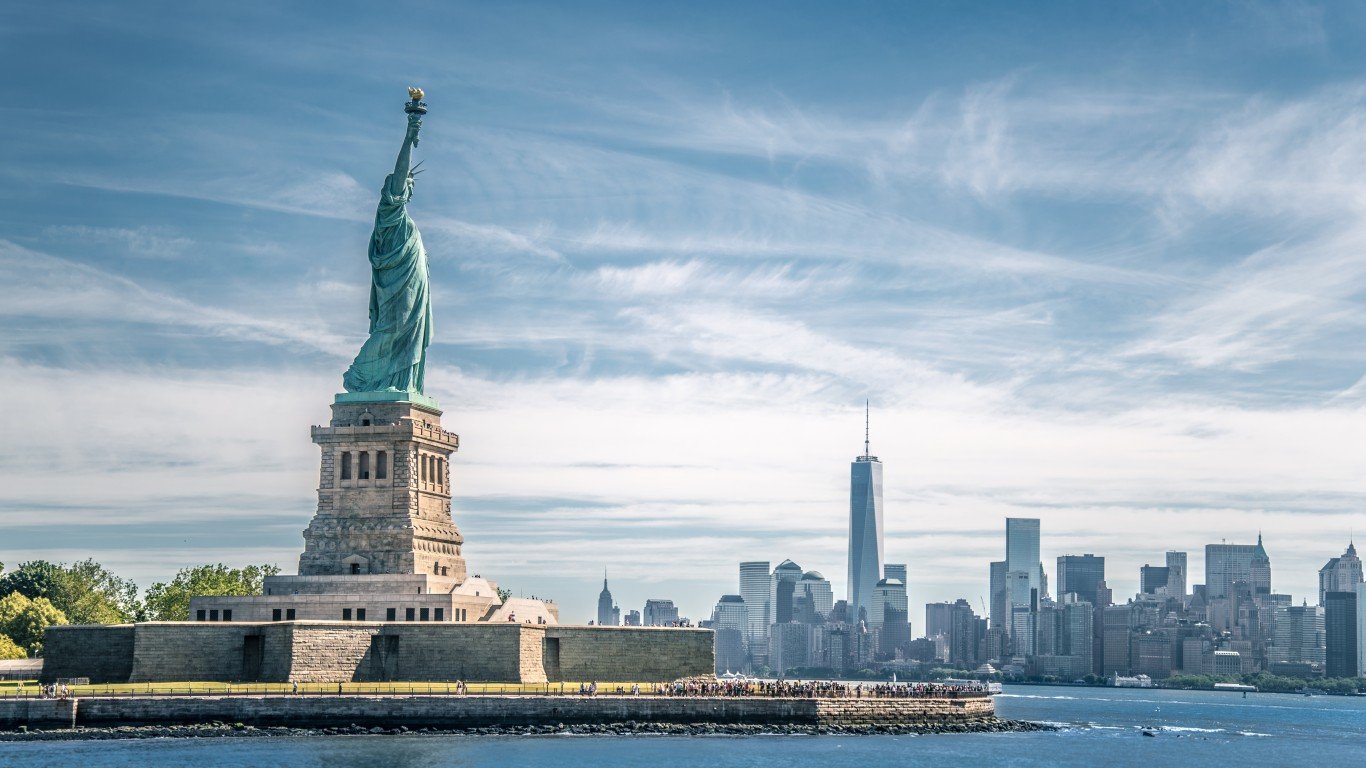
28. New York City, USA
> City population: 8,550,000
> Country population: 329,256,465
> Pct. of United States’s population: 2.6%
New York has been the largest American city ever since the first U.S. census in 1790. Today, it is twice the size of the second largest metropolis, Los Angeles. New York’s population grew from 80,000 to 3.4 million in the course of the 19th century. Growth slowed after 1950, and a mass exodus from New York to the suburbs in the 1970s, said to have been driven by economic problems and a high crime rate, reduced the population by almost a million. The population grew again in the 1990s, before tapering off to a current growth rate of about 0.08%. The city has by far the highest population density in the country — Manhattan alone contains about 66,000 people per square mile — and boasts a longer life expectancy than America as a whole.
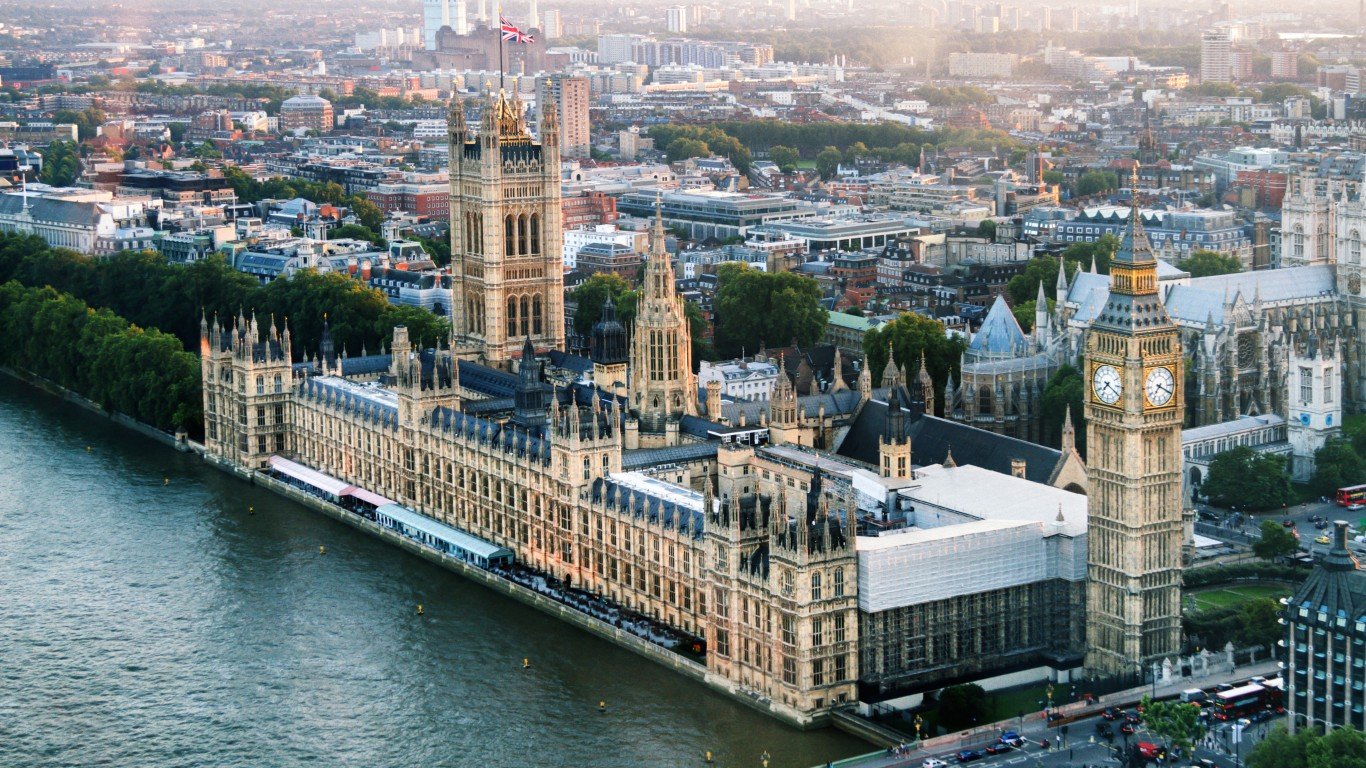
27. London, UK
> City population: 8,674,000
> Country population: 65,105,246
> Pct. of United Kingdom’s population: 13.3%
London — not to be confused with the City of London, which is the British capital’s financial district and historic heart — is the U.K.’s largest municipality by far. (The second largest, Birmingham, has just over a million residents.) London is also the largest city in the European Union, at least until next year, and the third largest in Europe, after Istanbul and Moscow. As early as the second century A.D., under Roman rule, the city had a population of about 60,000, and it hit the million-person mark in the early 19th century. After a decline in population following World War II, the city began growing again in the 1980s. It is estimated that over a third of London’s residents today were born outside the U.K.
[in-text-ad-2]
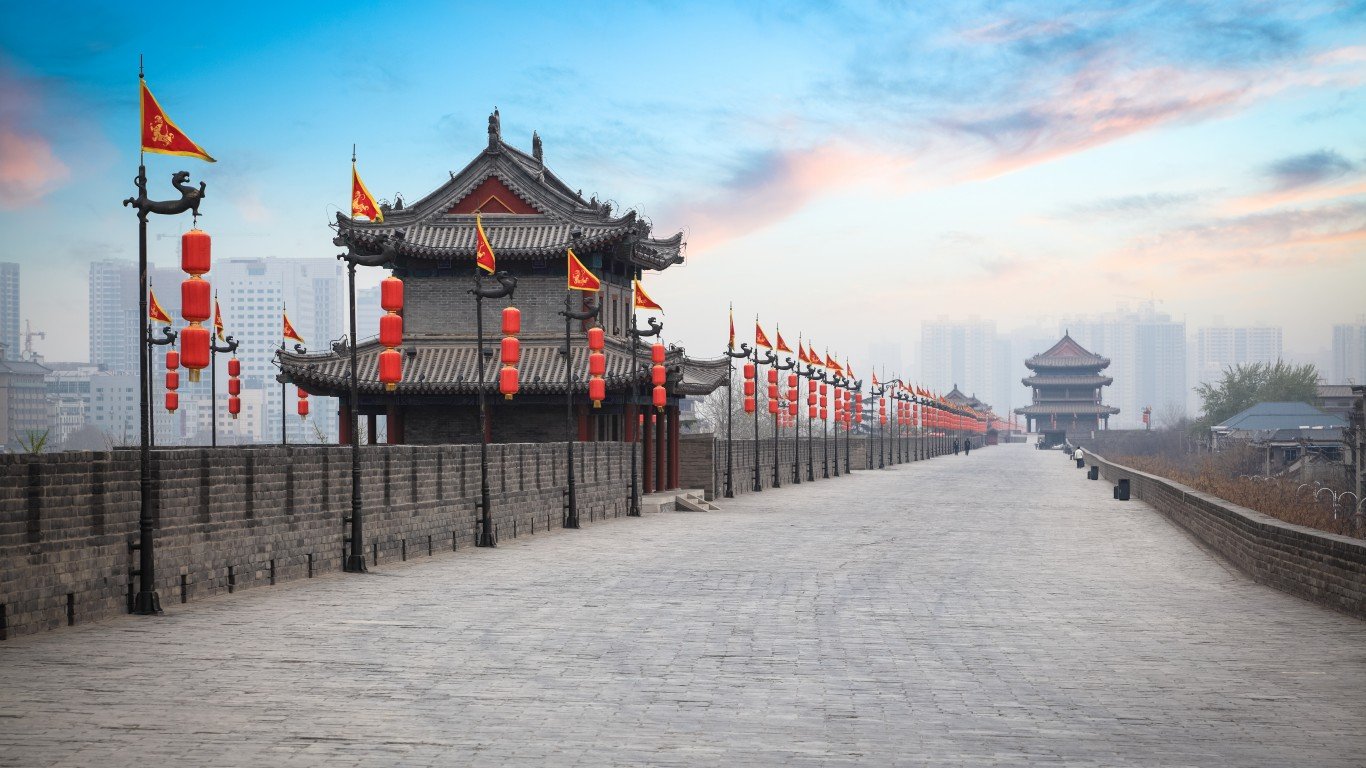
26. Xi’an, China
> City population: 8,705,000
> Country population: 1,384,688,986
> Pct. of China’s population: 0.6%
Home of the famous Qin Dynasty terracotta warriors and eastern terminus of the legendary Silk Road, Xi’an is now a major business and industrial center, and the focal point of China’s economic Western Development Program. The city has grown dramatically in size since 2000, when it had a population of less than 4 million, thanks largely to new investment and employment opportunities.
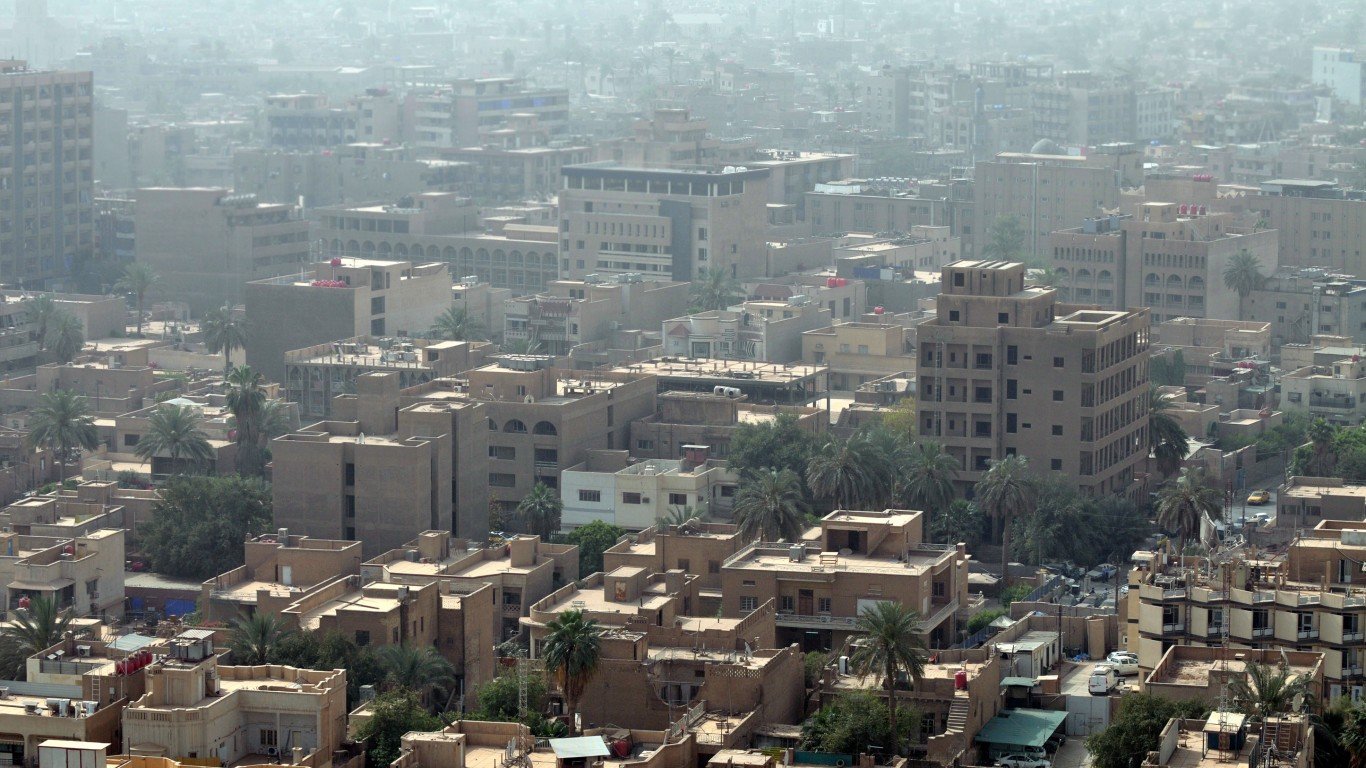
25. Baghdad, Iraq
> City population: 8,765,000
> Country population: 40,194,216
> Pct. of Iraq’s population: 21.8%
Founded in 762 A.D., this now troubled city became one of the world’s great cultural centers, with a population as high as 500,000 in the 9th century. Its golden age came to an end after it was conquered by the Mongols in the mid-13th century and then effectively destroyed by Timur Lenk (Tamerlane) in 1401. It languished as a provincial capital under the Ottomans, its population plummeting to about 50,000. It did not regain its importance — or dramatically increase its number of residents — until after it became the capital of the newly formed nation of Iraq in 1921. In the 25 years between 1965 and 1990, its population soared from nearly 1.5 million to about 5 million, and it continues to increase with an annual growth rate of 2.3%.
[in-text-ad]

24. Tehran, Iran
> City population: 8,847,000
> Country population: 83,024,745
> Pct. of Iran’s population: 10.7%
The 28th capital of Iran — or its predecessor, Persia — since the time of Cyrus the Great (c. 600-530 B.C.), Tehran was home to a mere 200,000 people in 1900, growing exponentially over the next hundred years. Mass migrations from other parts of Iran have continued to swell its numbers into the 21st century, though the growth rate is now relatively stable. It is the largest city in western Asia (as most of Istanbul’s population lives in the European part of the country).

23. Mexico City, Mexico
> City population: 8,919,000
> Country population: 125,959,205
> Pct. of Mexico’s population: 7.1%
Mexico City is a major destination for expatriates from all over the Americas, Europe, the Middle East, and, increasingly, Asia. It is estimated that there are about 700,000 U.S. citizens residing in the city. About 20% of Mexico’s total population lives in the area surrounding the capital, some 4 million of them in the massive slum town of Neza-Chalco-Itza. Though Mexico City’s population continues to increase — it is expected that the metropolitan area will be home to at least 22 million people by 2020 — the rate of growth is comparatively slow compared to that of other large cities.
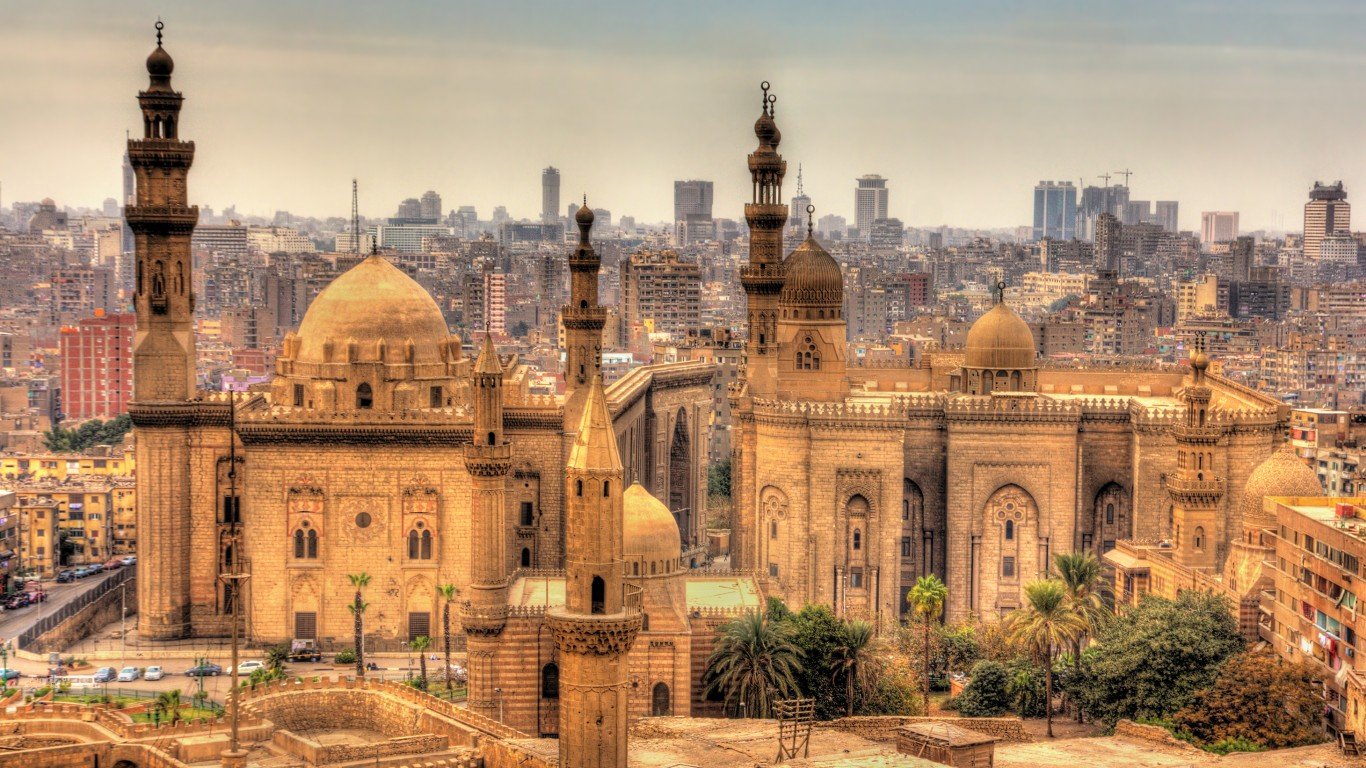
22. Cairo, Egypt
> City population: 9,500,000
> Country population: 99,413,317
> Pct. of Egypt’s population: 9.6%
The ancient city of Cairo is considered a prime example of a metropolis in a developing country whose population growth has outpaced its infrastructure and social services. The rate of that growth is currently 1.87%, largely accounted for by the city’s surprisingly low mortality rate of about seven deaths per 1,000 annually and high birth rate of 30 per 1,000. Along with Lagos and Kinshasa, Cairo is one of Africa’s largest cities.
[in-text-ad-2]
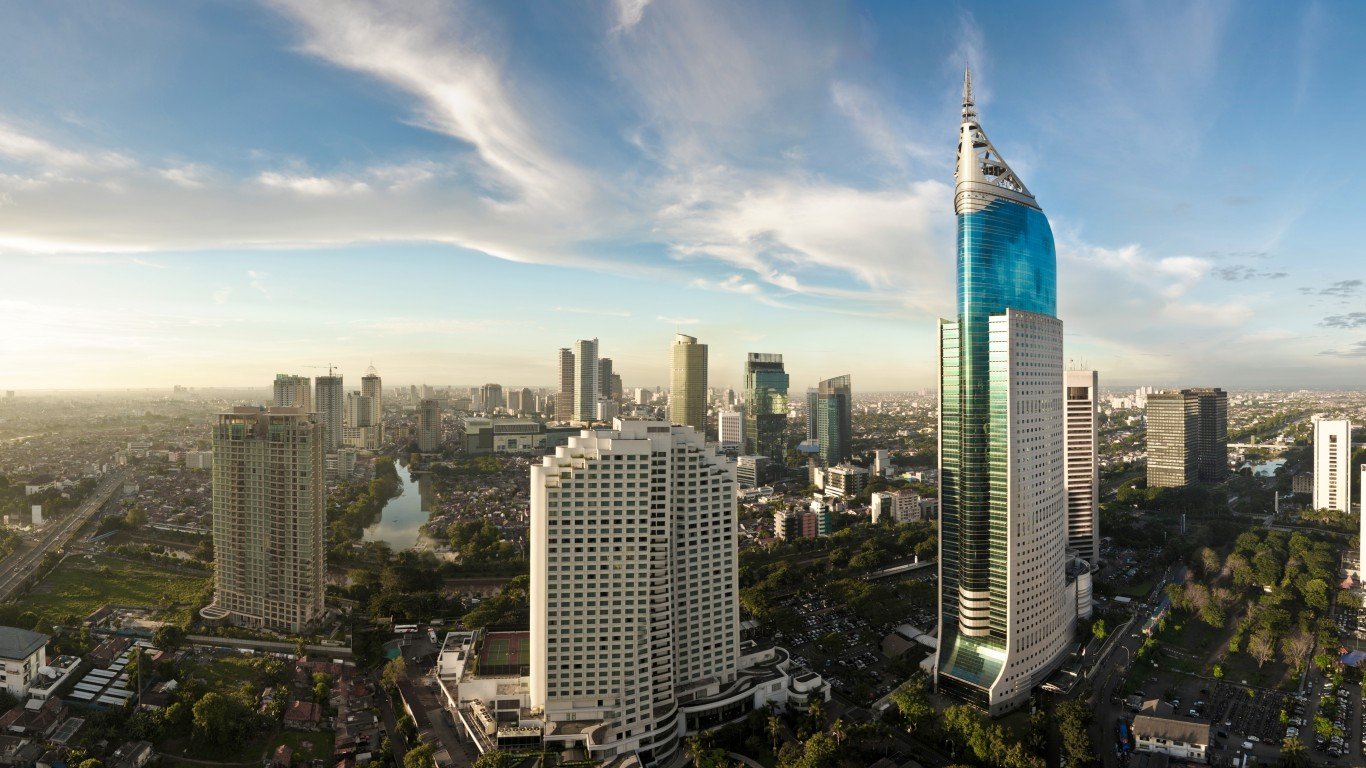
21. Jakarta, Indonesia
> City population: 9,608,000
> Country population: 262,787,403
> Pct. of Indonesia’s population: 3.7%
The capital of Indonesia, Jakarta boasts one of the fastest growing urban economies in the world, and also one of the highest population densities with over 40,000 people per square mile. The city’s massive metropolitan area has its own name, Jabodetabek, based on the initials for the localities of Jakarta, Bogor, Depok, Tangerang, and Bekasi. About 250,000 people immigrate to Jabodetabek every year.

20. Lima, Peru
> City population: 9,752,000
> Country population: 31,331,228
> Pct. of Peru’s population: 31.1%
In 1535, after Francisco Pizarro founded it, the future capital of Peru had a population of about 250. It grew slowly and had only about 50,000 residents by 1750 and 500,000 by 1940. After World War II, many thousands of poor Peruvians from the Andes moved to the city seeking work, and by 1970 — after its boundaries had extended towards both the sea and the mountains and subsumed the suburbs of Callao, Miraflores, and Chorrillos — it held five times its 1940 population. Two domestic militant groups terrorized the countryside between 1980 and 2000 and scared hundreds of thousands of farmers and their families into Lima, setting off a growth spurt that has not abated.
[in-text-ad]
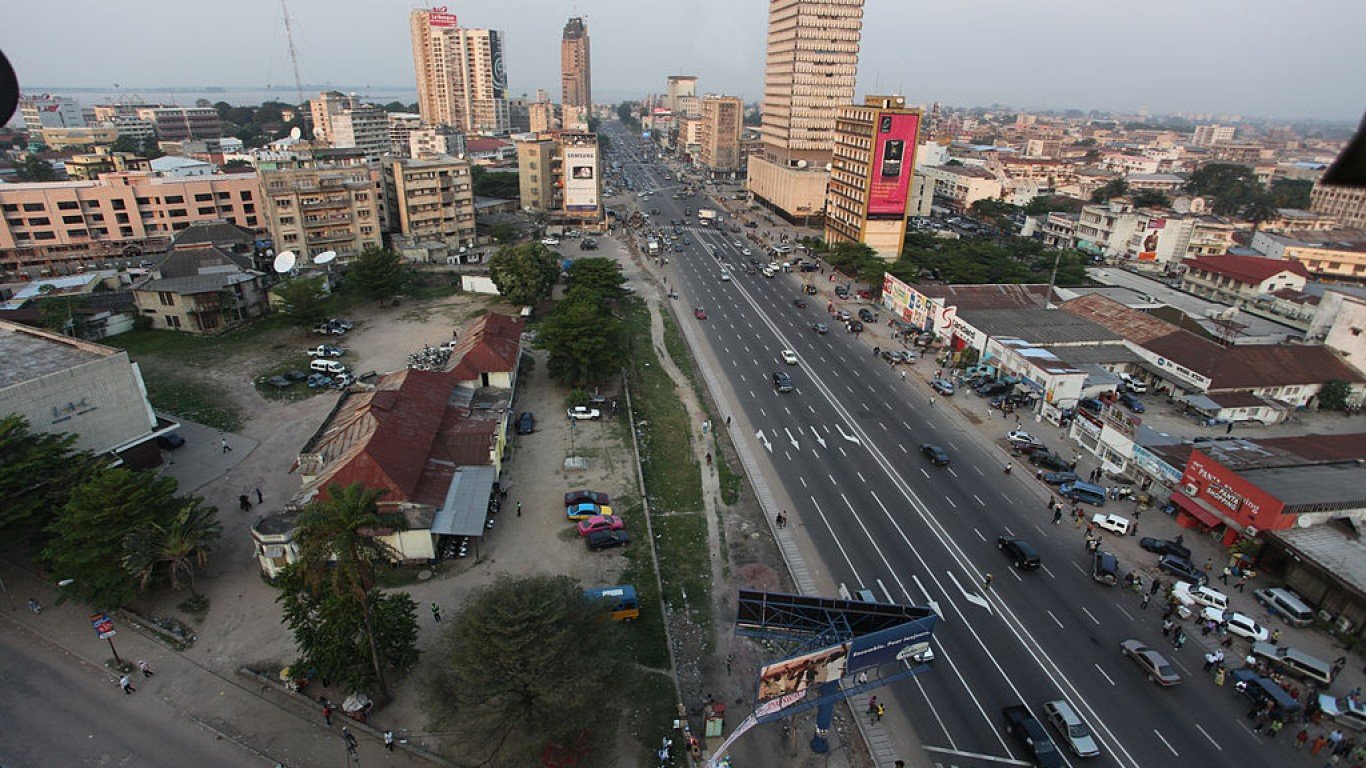
19. Kinshasa, Democratic Republic of the Congo
> City population: 10,125,000
> Country population: 81,339,988
> Pct. of Congo D.R.’s population: 12.4%
Kinshasa, the largest city on the African continent (and also a back-and-forth rival to Paris as the leading francophone city in the world), is the capital of the Democratic Republic of the Congo. This is not to be confused with the neighboring Republic of Congo, and to make that clear, the Democratic Republic is often called Congo-Kinshasa, while its neighbor is Congo-Brazzaville, after its capital. A one-time trading port on the Congo River, Kinshasa grew slowly, from about 5,000 people in 1889 to 23,000 in 1923. After 1950, though, its numbers doubled about every five years. At one time, the capital drew immigrants from western and central Africa, but today most newcomers are from elsewhere in the country itself.
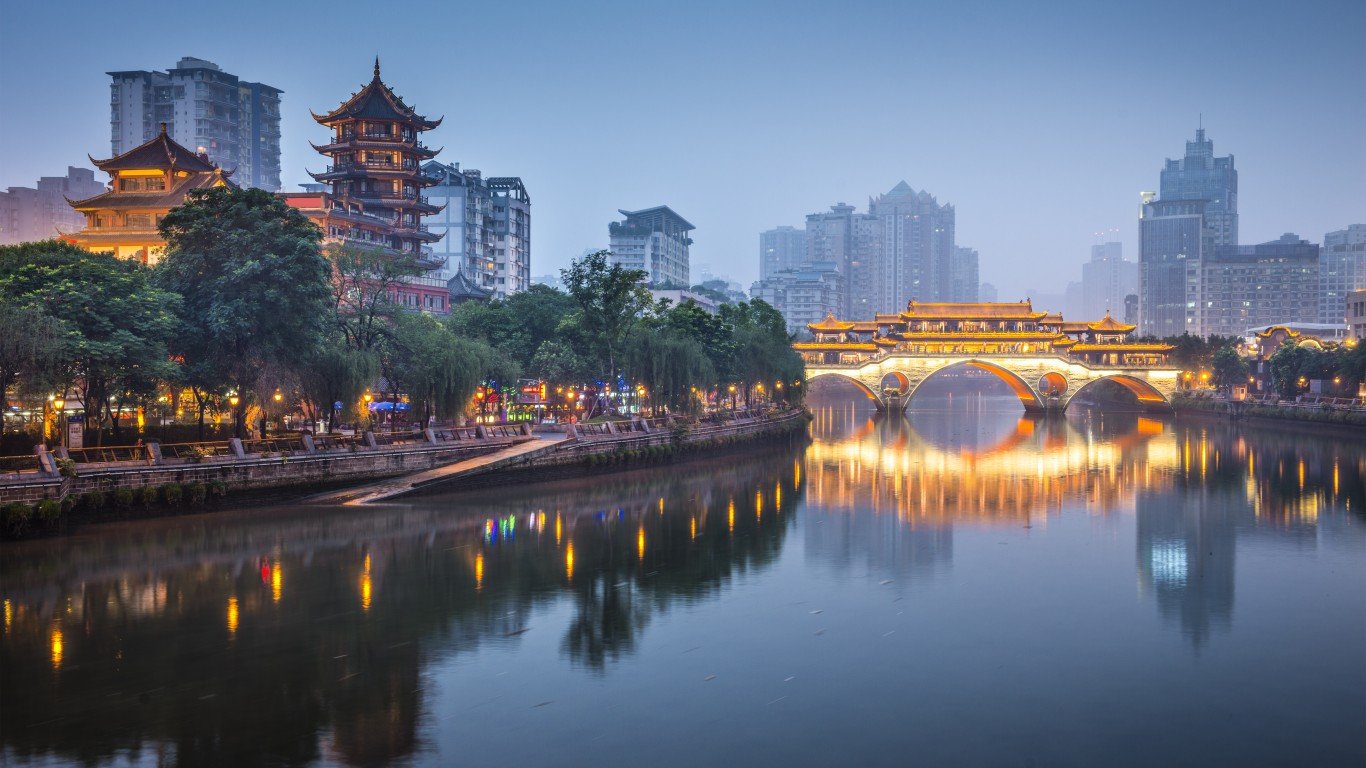
18. Chengdu, China
> City population: 10,152,000
> Country population: 1,384,688,986
> Pct. of China’s population: 0.7%
The capital of Sichuan province in western China, Chengdu is a major financial and business center. More than half the Fortune 500 companies maintain offices there, and Chengdu Shuangliu International Airport is one of the busiest in the world. The city can perhaps credit its financial acumen at least in part to having been one of the first places in the world to produce paper money, during the Song Dynasty (960-1279 A.D.). Thanks largely to the employment opportunities it offers and its relatively low cost of living, Chengdu’s population has grown steadily since the mid-20th century, from 646,000 in 1950 to the current figure.
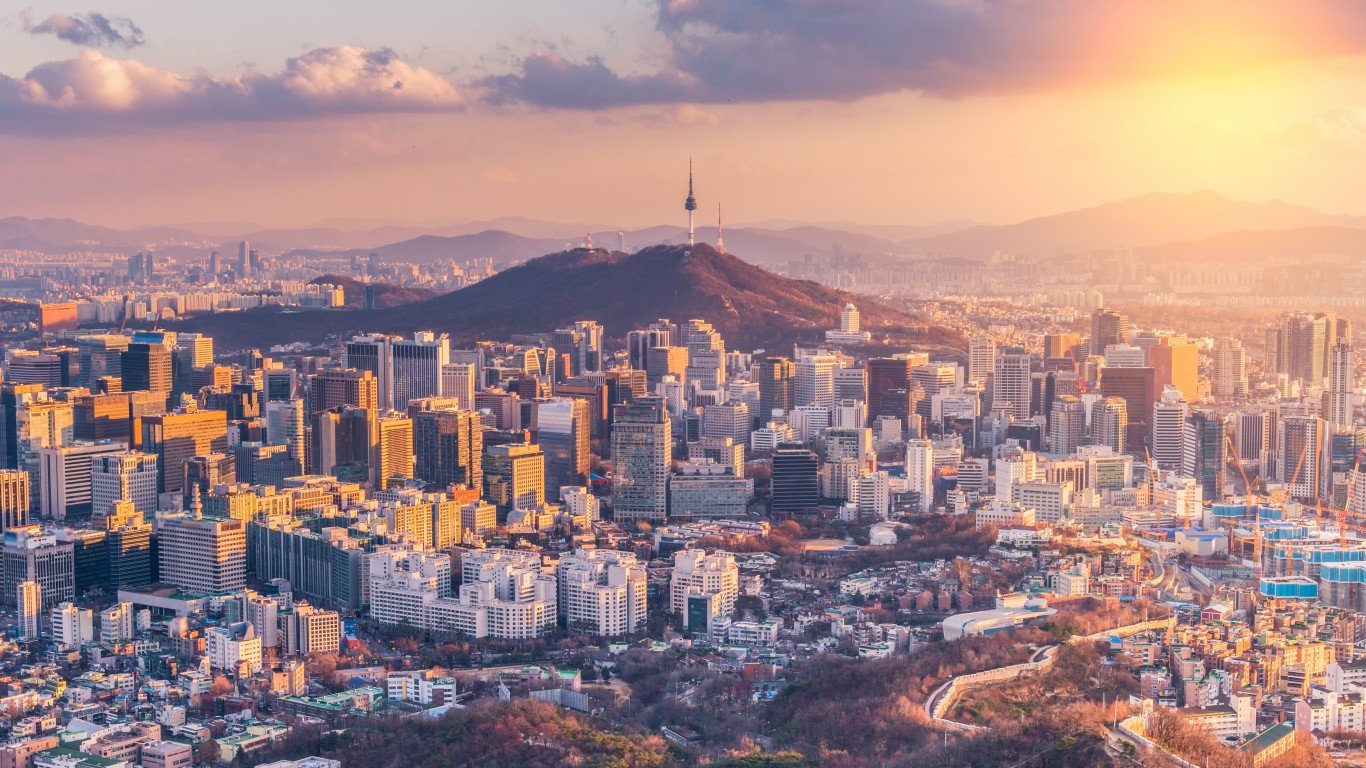
17. Seoul, South Korea
> City population: 10,290,000
> Country population: 51,418,097
> Pct. of South Korea’s population: 20.0%
Seoul Special City, as the capital of South Korea is officially called, sits in the midst of one of the largest metropolitan areas in the world, comprising about half of the country’s entire population. Though it spans about 233 square miles, Seoul has a population density almost twice that of New York City. The number of inhabitants has declined, however, since 2011, thanks to a very low birth rate and an aging population.
[in-text-ad-2]
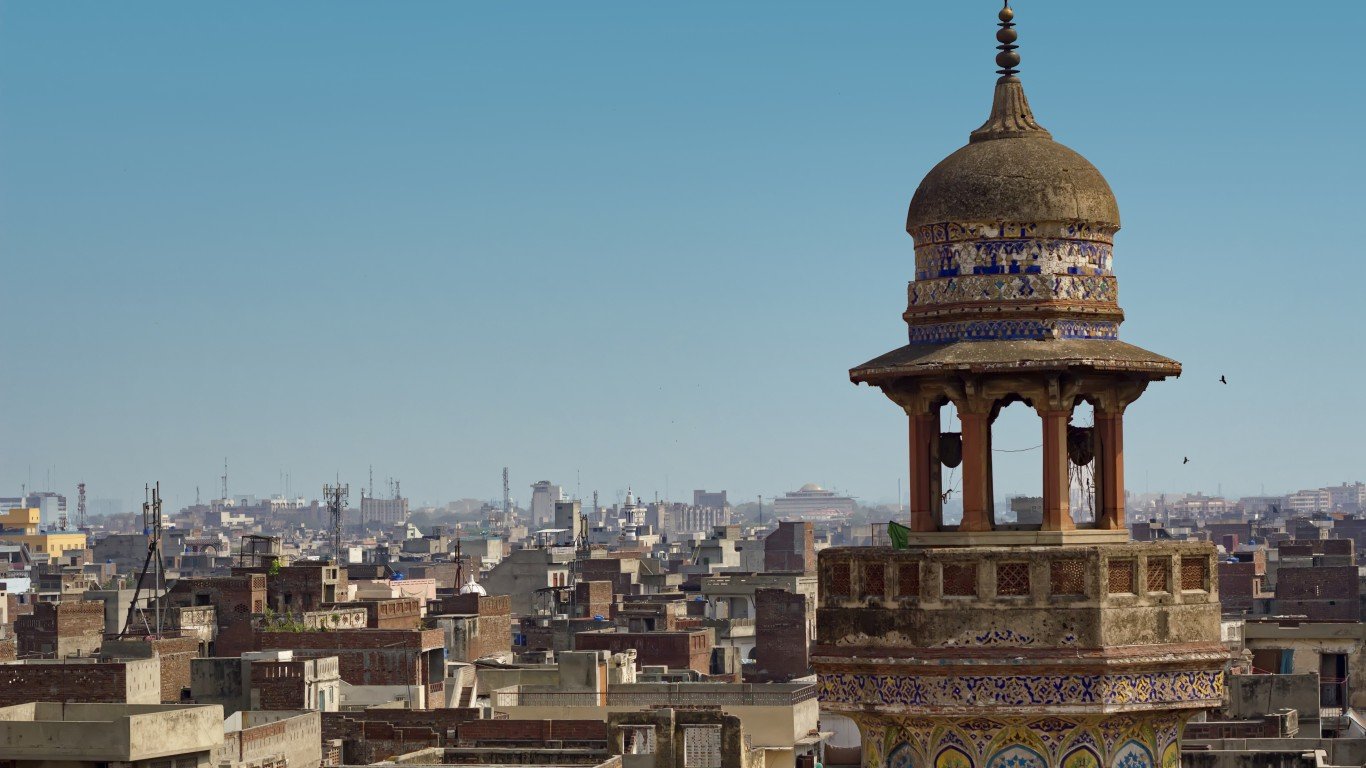
16. Lahore, Pakistan
> City population: 10,355,000
> Country population: 207,862,518
> Pct. of Pakistan’s population: 5.0%
Known as Pakistan’s cultural capital and an important engineering center, this historic city in the country’s northwestern corner has grown to more than 10 million people from barely a million in 1955. It is the second largest city in the country after Karachi, though the 2017 Pakistan census revealed that its population had grown about twice as fast as Karachi’s between 1998 and last year.
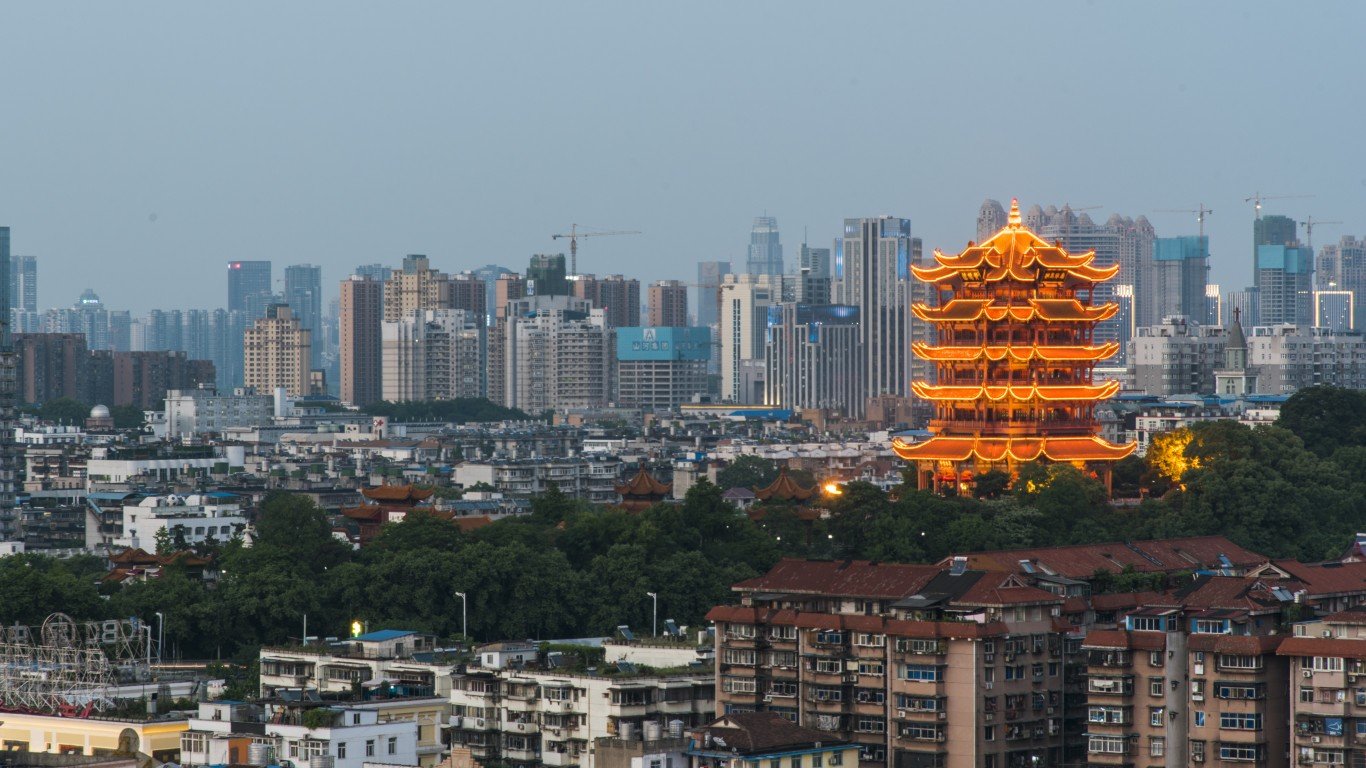
15. Wuhan, China
> City population: 10,608,000
> Country population: 1,384,688,986
> Pct. of China’s population: 0.8%
A major transportation hub — it is an important railroad and shipping center and is developing an international airport that will offer direct flights to five continents — Wuhan has been dubbed “the Chicago of China.” With a strong economy and major industrial zones, it has drawn residents from other parts of China, including Hong Kong and Macau, as well as immigrants from Taiwan, South Korea, and Japan.
[in-text-ad]
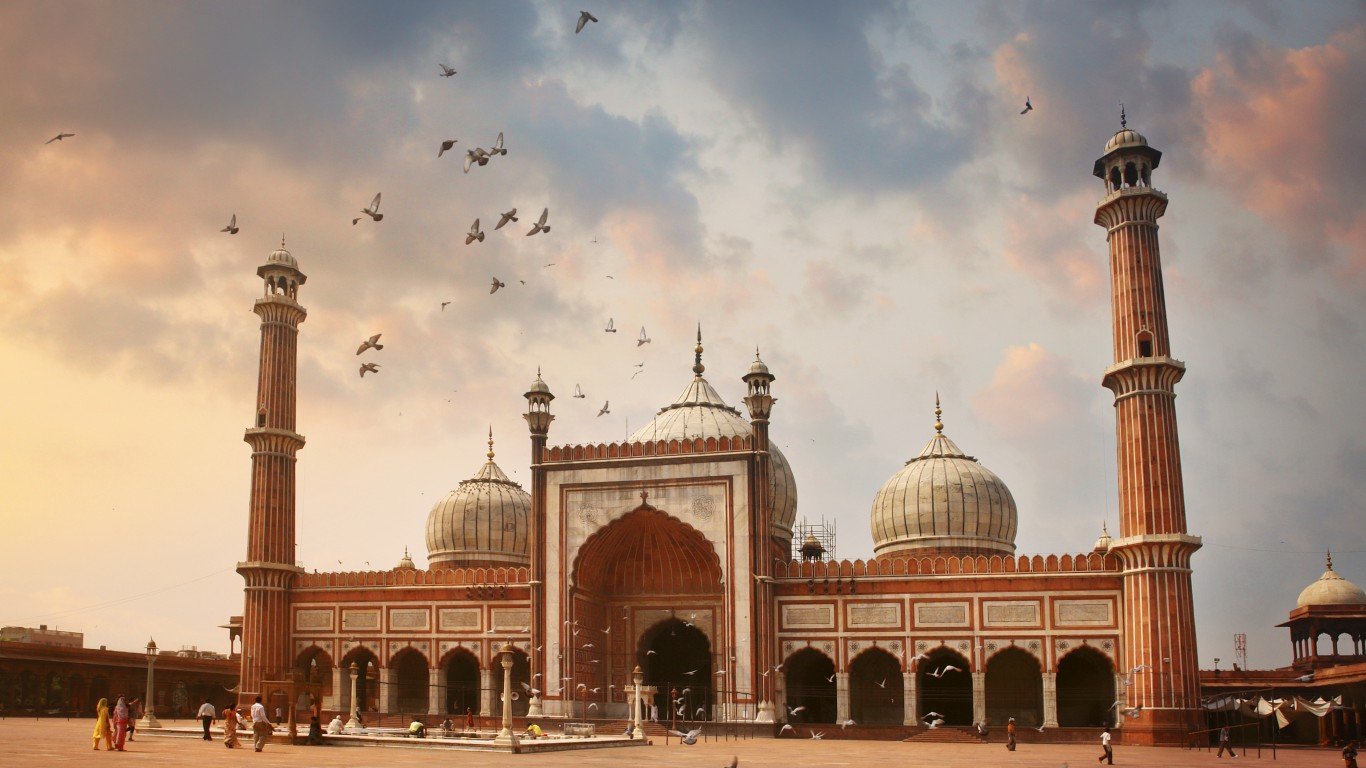
14. Delhi, India
> City population: 11,035,000
> Country population: 1,296,834,042
> Pct. of India’s population: 0.9%
Officially called the National Capital Territory of India, Delhi surrounds the actual administrative and political capital, New Delhi, this northern Indian metropolis is considered one of the fastest growing major cities in the world. Its population today is roughly eight times what it was in 1950, due to both natural growth and inbound migration.
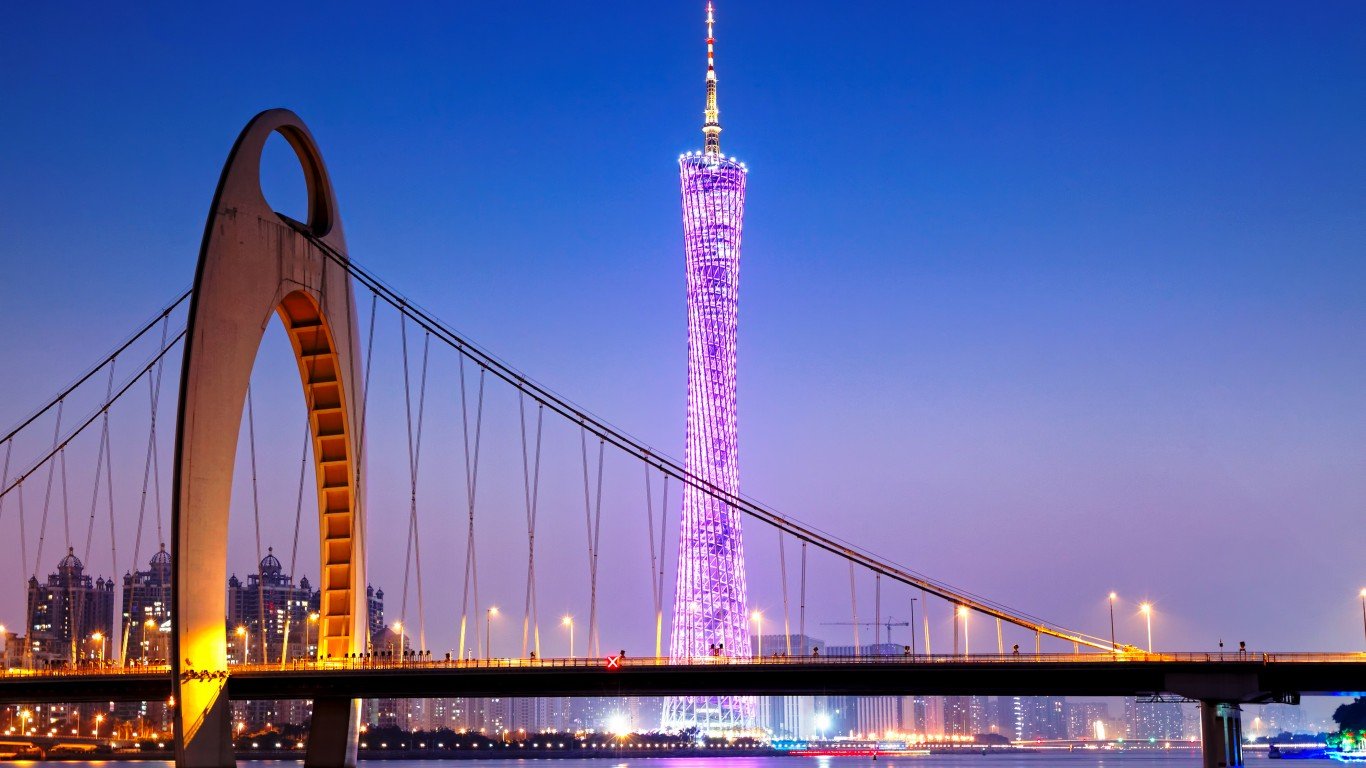
13. Guangzhou, China
> City population: 11,548,000
> Country population: 1,384,688,986
> Pct. of China’s population: 0.8%
Formerly known as Canton, this Pearl River capital draws immigrants from all over China.
Guangzhou’s urban area is in the midst of a population boom, with the growth rate more than doubling from 2010 to 2015 and remaining relatively high. Researchers for the Organization for Economic Co-operation and Development believe that the permanent population might number as much as 25 million if they include what they call its “functional urban area,” a new way of defining municipal limits.
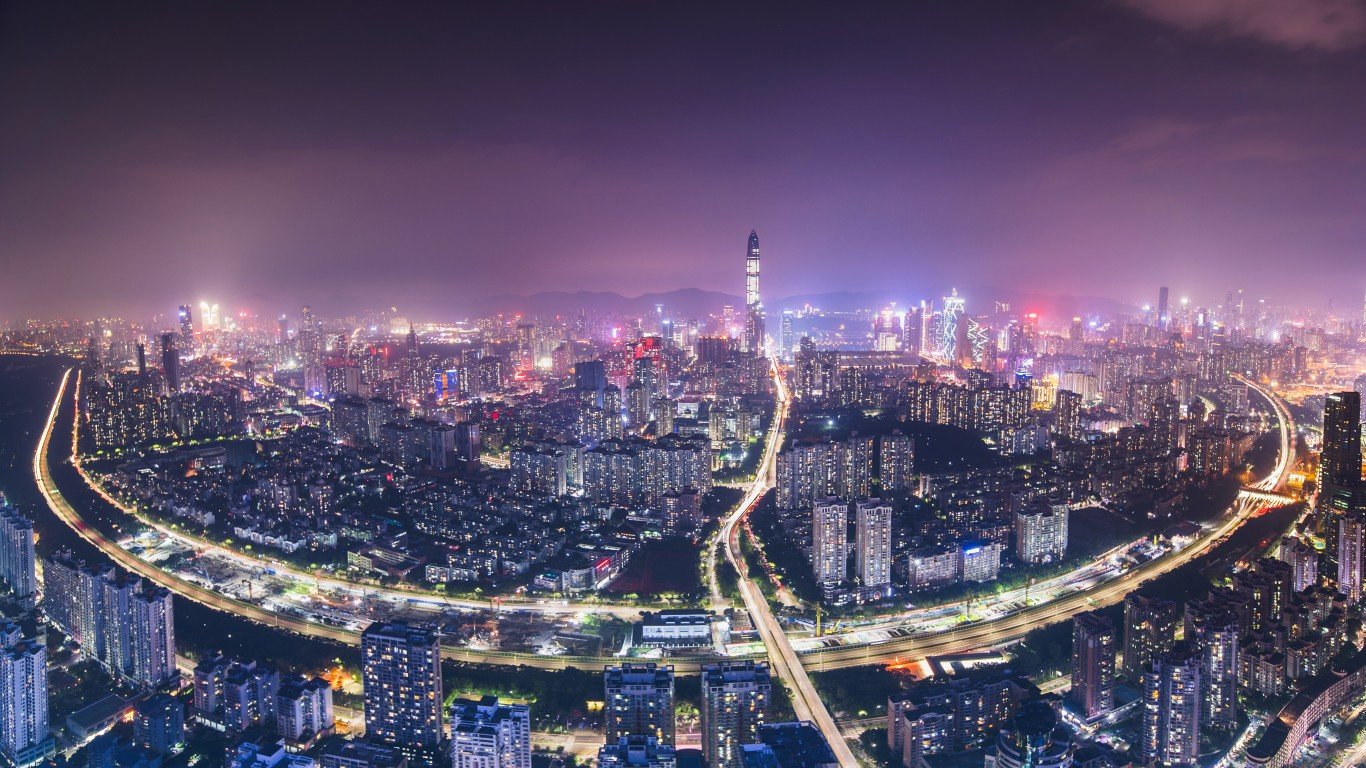
12. Shenzhen, China
> City population: 11,908,000
> Country population: 1,384,688,986
> Pct. of China’s population: 0.9%
A cultural and economic capital, Shenzhen has been named both China’s Most Charitable City for its many volunteer social organizations and an “Excellent Tourist City” by the Chinese government. Shenzhen was a village of 3,000 people in 1950. Exponential growth occurred between 1995 and 2000, when the population skyrocketed from 2,394,000 to 6,550,000.
[in-text-ad-2]
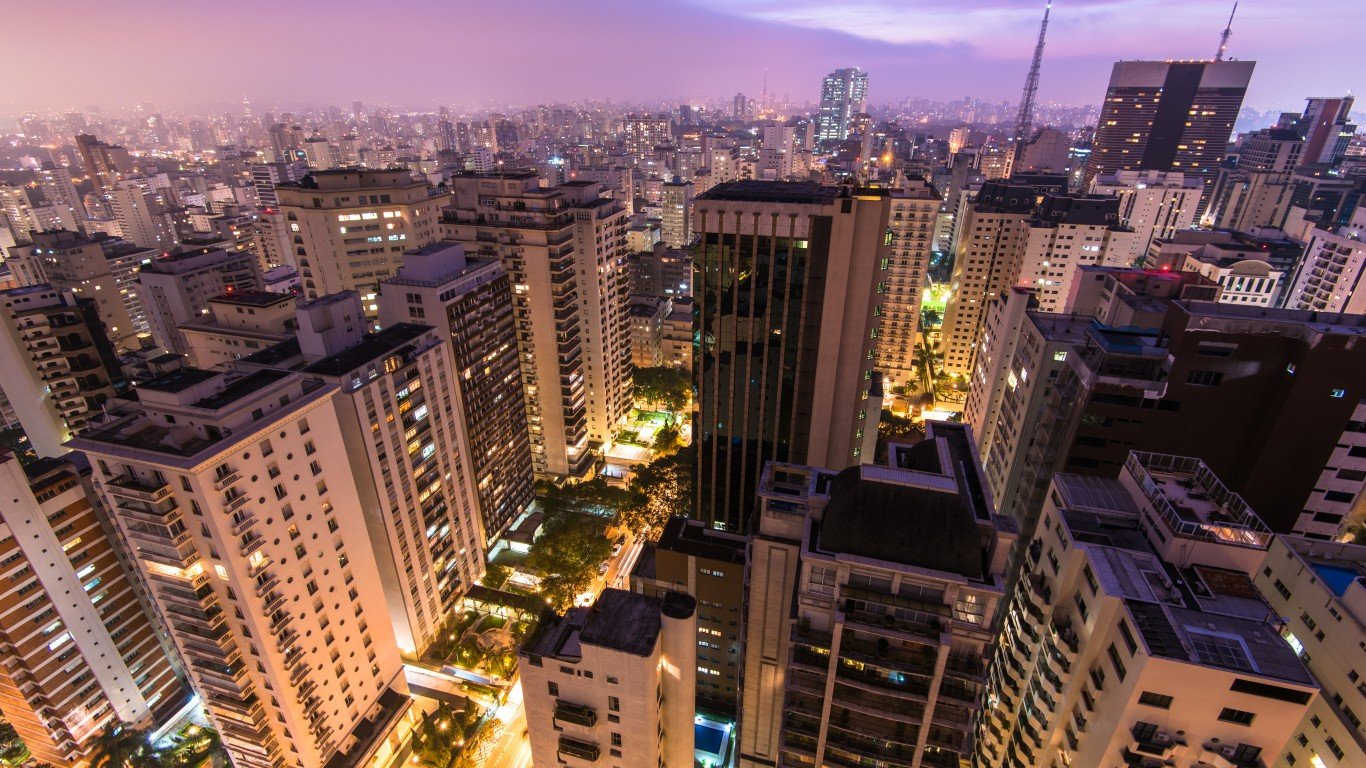
11. São Paulo, Brazil
> City population: 12,038,000
> Country population: 208,846,892
> Pct. of Brazil’s population: 5.8%
The largest city in the Americas and in the southern hemisphere, São Paulo is famous for its ethnic diversity. The city is home to the largest Japanese population outside Japan and boasts more residents of Italian origin than any city other than Rome and Milan. Currently there is also a substantial influx of Bolivians seeking work in the city’s many garment factories. Urban sprawl is so extensive that if you measured its so-called Complexo Metropolitano Expandido, or Expanded Metropolitan Complex — equivalent to what we call a Combined Statistical Area in the U.S. — it would rank as the third largest city in the world, with a population of more than 27 million.
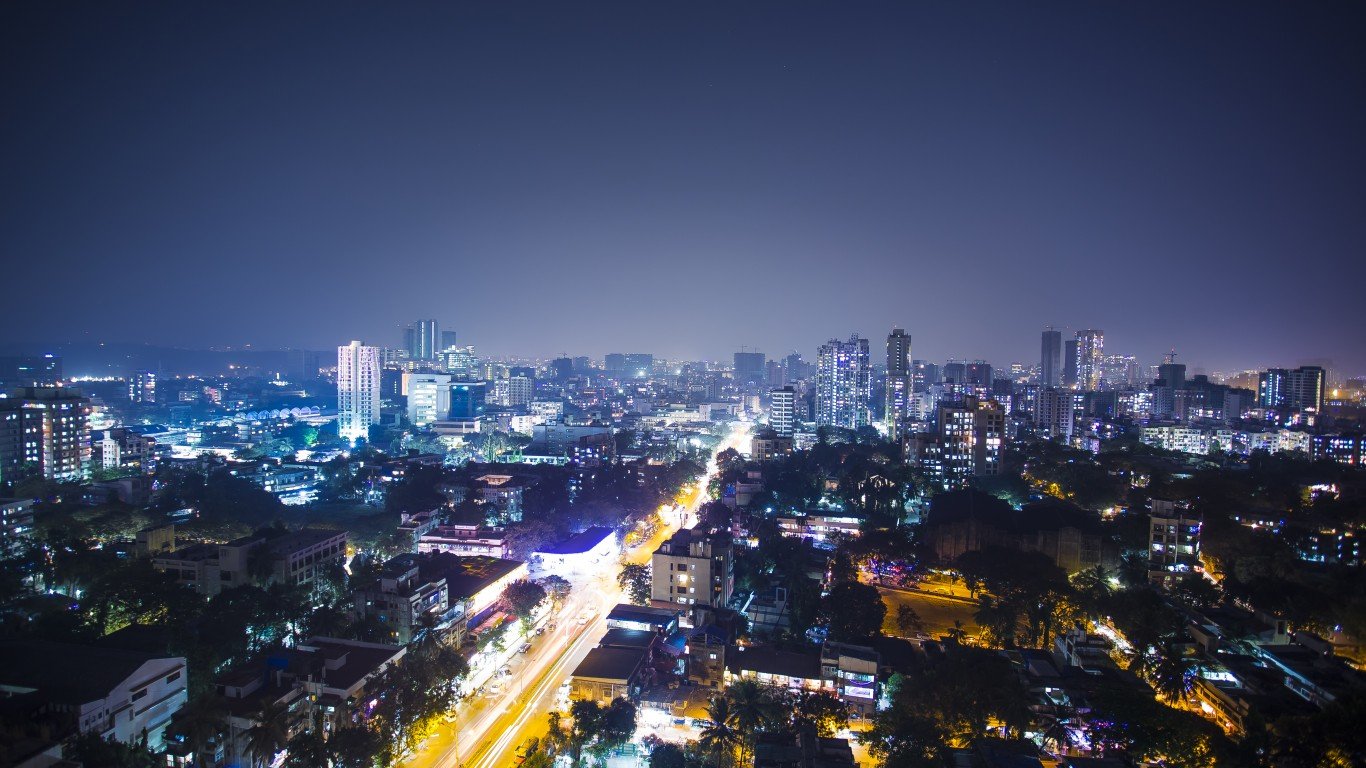
10. Mumbai, India
> City population: 12,400,000
> Country population: 1,296,834,042
> Pct. of India’s population: 1.0%
India’s biggest city and its main business hub, the city formerly known as Bombay, has more than doubled in population since 1991. Employment opportunities continue to draw newcomers from all over India, and the rapid influx has overwhelmed city services. More than 5,000 metric tons of solid waste are generated daily in Mumbai, and more than 40% of the residents of Greater Mumbai are estimated to live in slums.
[in-text-ad]
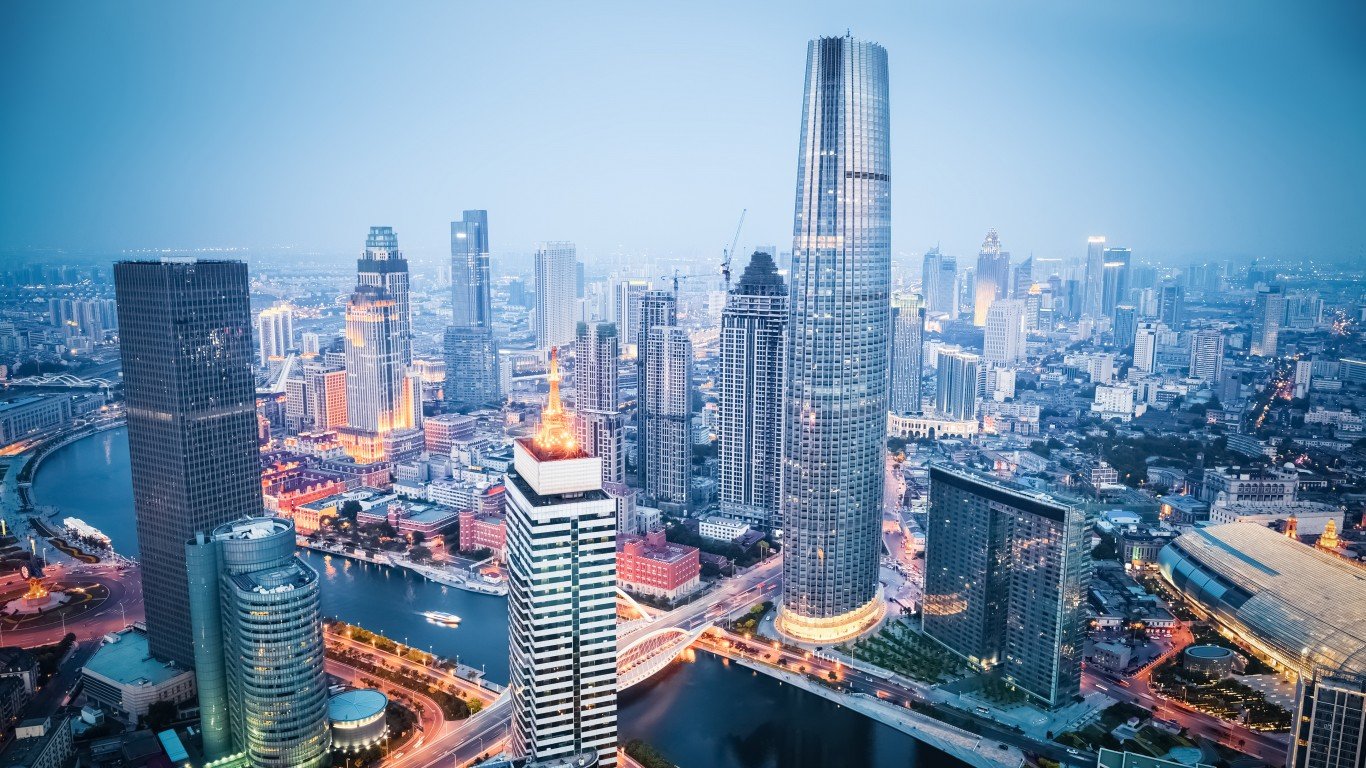
9. Tianjin, China
> City population: 12,784,000
> Country population: 1,384,688,986
> Pct. of China’s population: 0.9%
China’s largest coastal city, Tianjin became a major trading port in the late 19th century. In the 1970s, it benefited from the economic reforms that opened China to new foreign investment and permitted entrepreneurs to set up private businesses. Between 1980 and 2000, Tianjin’s population almost doubled, and it has since almost doubled again.
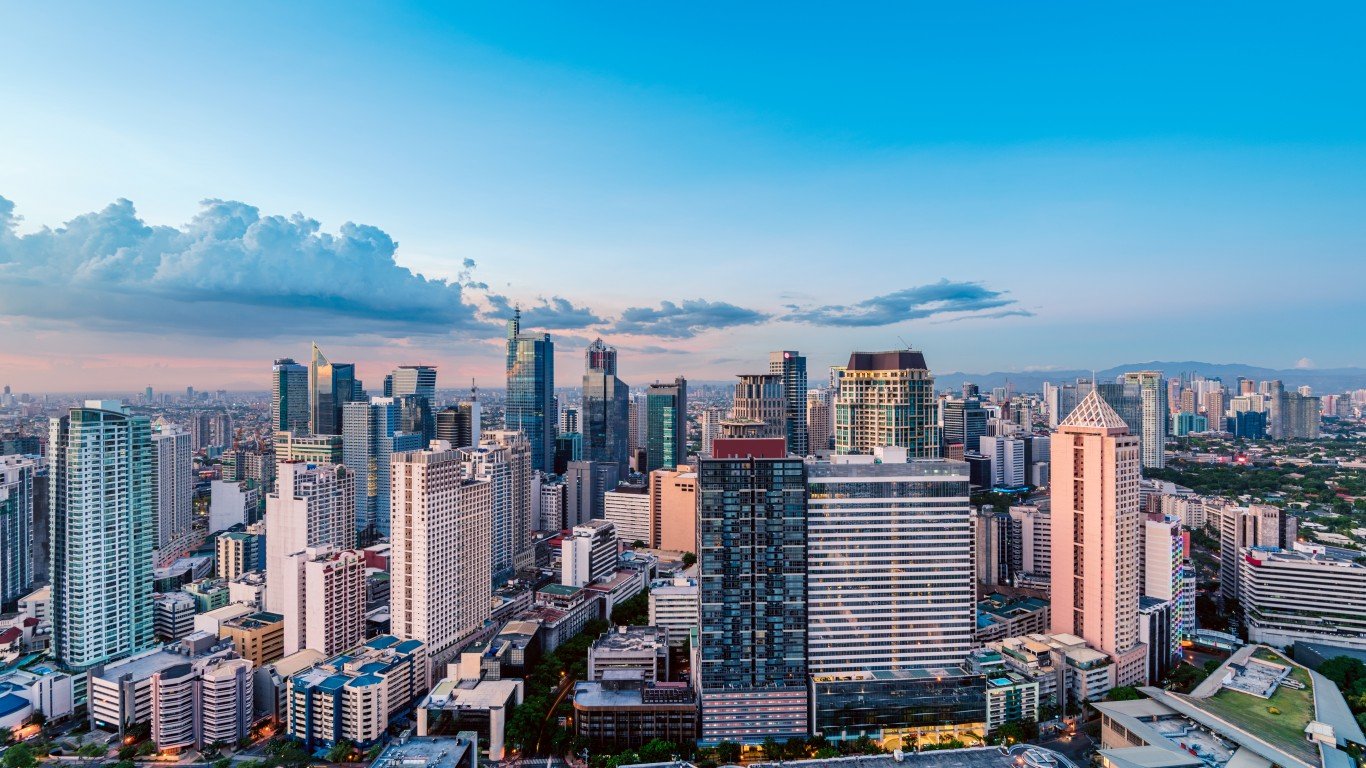
8. Manila, Philippines
> City population: 12,877,000
> Country population: 105,893,381
> Pct. of Philippine’s population: 12.2%
Manila has been densely populated almost since it was founded in 1571, but its first urban plan, drawn up in 1905, made provision for a city of only 800,000. Today, with more than 12 million residents, among the most densely populated metropolises in the world. It has been estimated that the population continues to grow by about 60 people per hour. Controversial Philippines president Rodrigo Duterte suggested in late 2017 that Manila would be a “dead city” in 25 years. To take its place, he announced that the government and private enterprise would collaborate to build a new city on the site of the former Clark Air Force Base, 53 miles northwest of Manila, at an estimated cost of $14 billion.

7. Moscow, Russia
> City population: 13,197,596
> Country population: 142,122,776
> Pct. of Russia’s population: 9.3%
The most populous city in Europe and the world’s northernmost mega-city, Moscow grew by 10.9% between 2002 and 2010, and has gained at least a million new residents since then. However, population figures for the Russian capital are known to be inexact due to its large number of temporary residents and a continuing inflow of both legal and illegal immigrants from elsewhere in Russia and the former Soviet republics. Average salaries in Moscow are about double what they are elsewhere in Russia, and the city is said to have the third most billionaires of any city in the world, after New York and Hong Kong.
[in-text-ad-2]

6. Tokyo, Japan
> City population: 13,617,000
> Country population: 126,168,156
> Pct. of Japan’s population: 10.8%
The intensely crowded Japanese capital is currently home to more than a tenth of the country’s residents. Established in the 15th century as a fishing village called Edo, it had become by the 1720s the first city in Asia with a population of more than a million. Renamed Tokyo in 1868, it is one of the world’s richest cities, and its metropolitan area is geographically among the largest in the world.
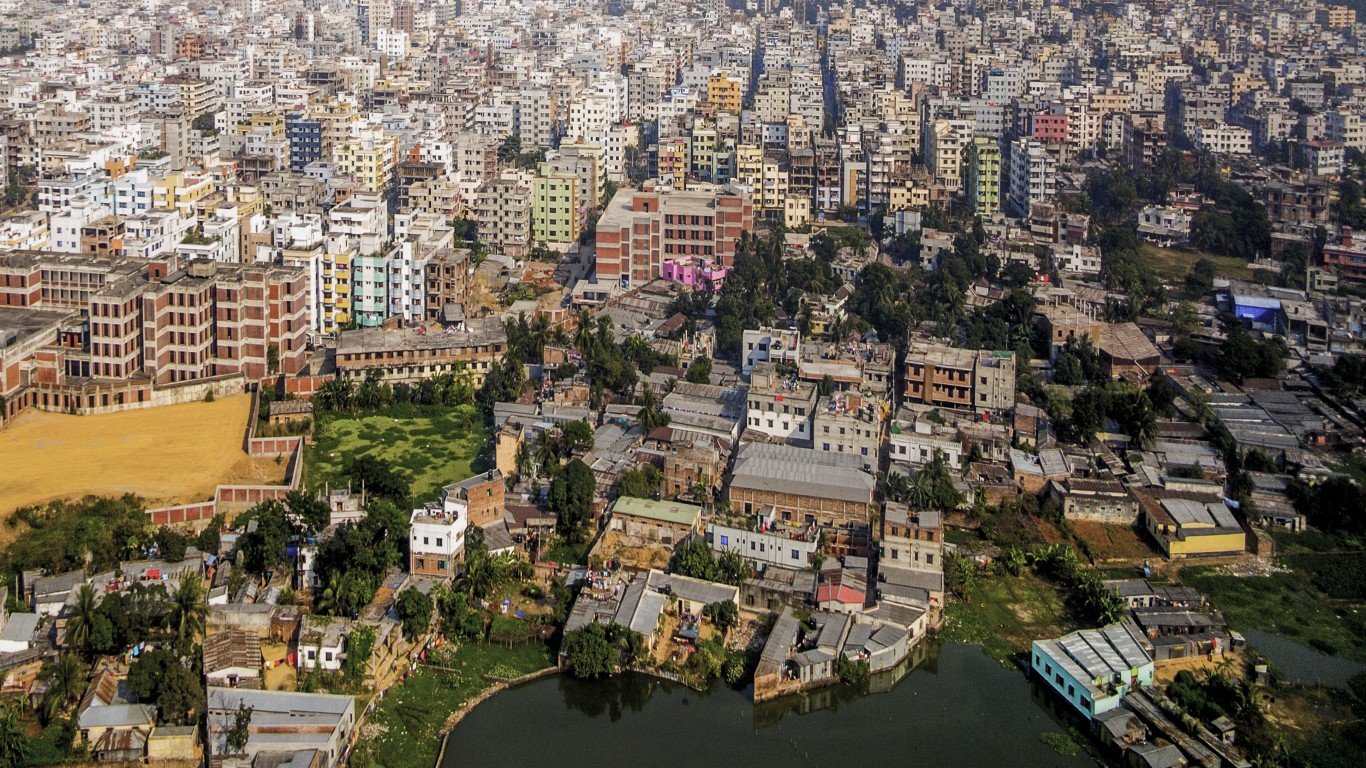
5. Dhaka, Bangladesh
> City population: 14,543,000
> Country population: 159,453,001
> Pct. of Bangladesh’s population: 9.1%
According to UN Habitat, Dhaka (formerly Dacca) is the world’s most densely populated city, with more than 115,000 people per square mile. Rural migration accounted for about 60% of the city’s population growth in the 1960s and ’70s, with many coming to work in its burgeoning textile industry. Dhaka has continued to grow since then, increasing by almost 2 million people just since 2015.
[in-text-ad]
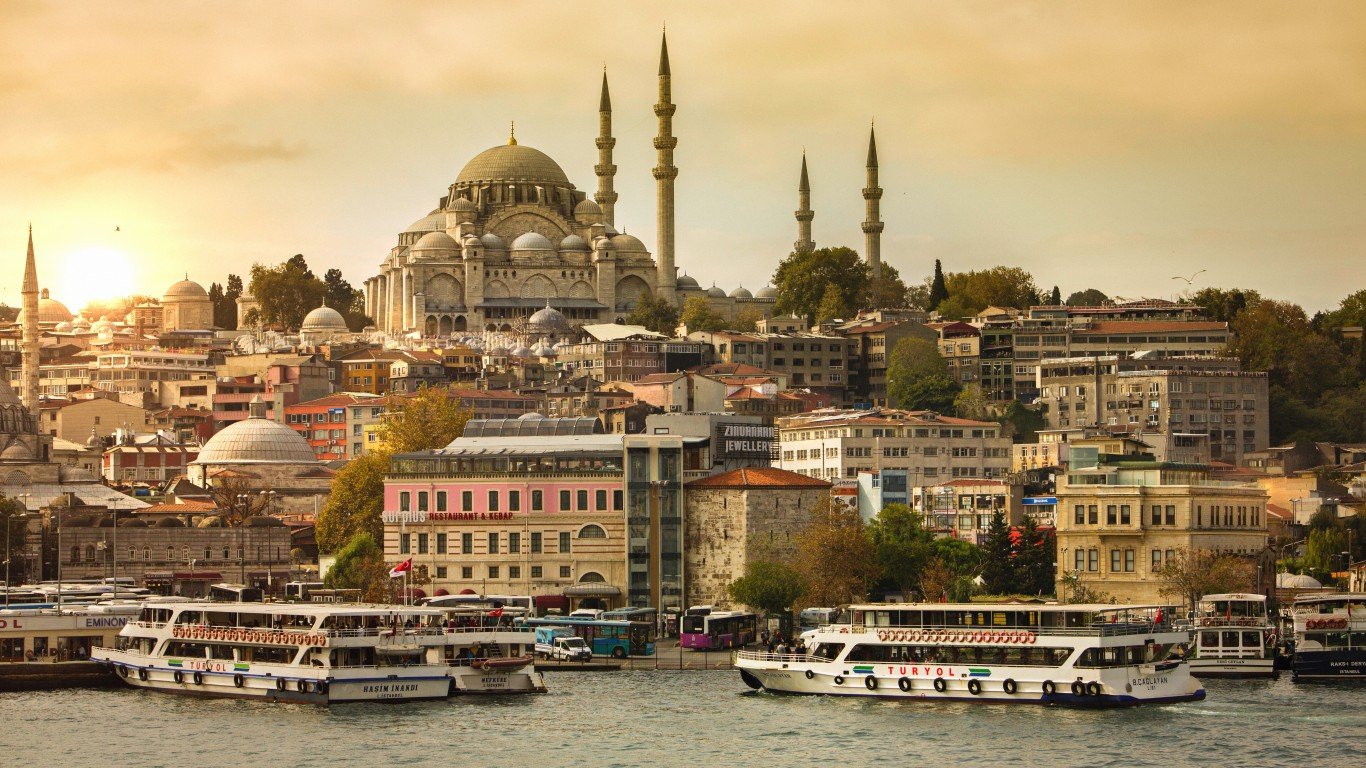
4. Istanbul, Turkey
> City population: 14,657,000
> Country population: 81,257,239
> Pct. of Turkey’s population: 18.0%
As early as 500 A.D., Constantinople — as Istanbul was called until 1930 — had a population as high as 500,000, making it the world’s largest city at the time, larger even than Rome. The modern metropolis grew rapidly throughout the late 20th century, rising from less than a million in 1950 to almost 9 million by 2000. It is unique among cities because it is located on two continents, Europe and Asia, with the Strait of Bosphorus separating them.
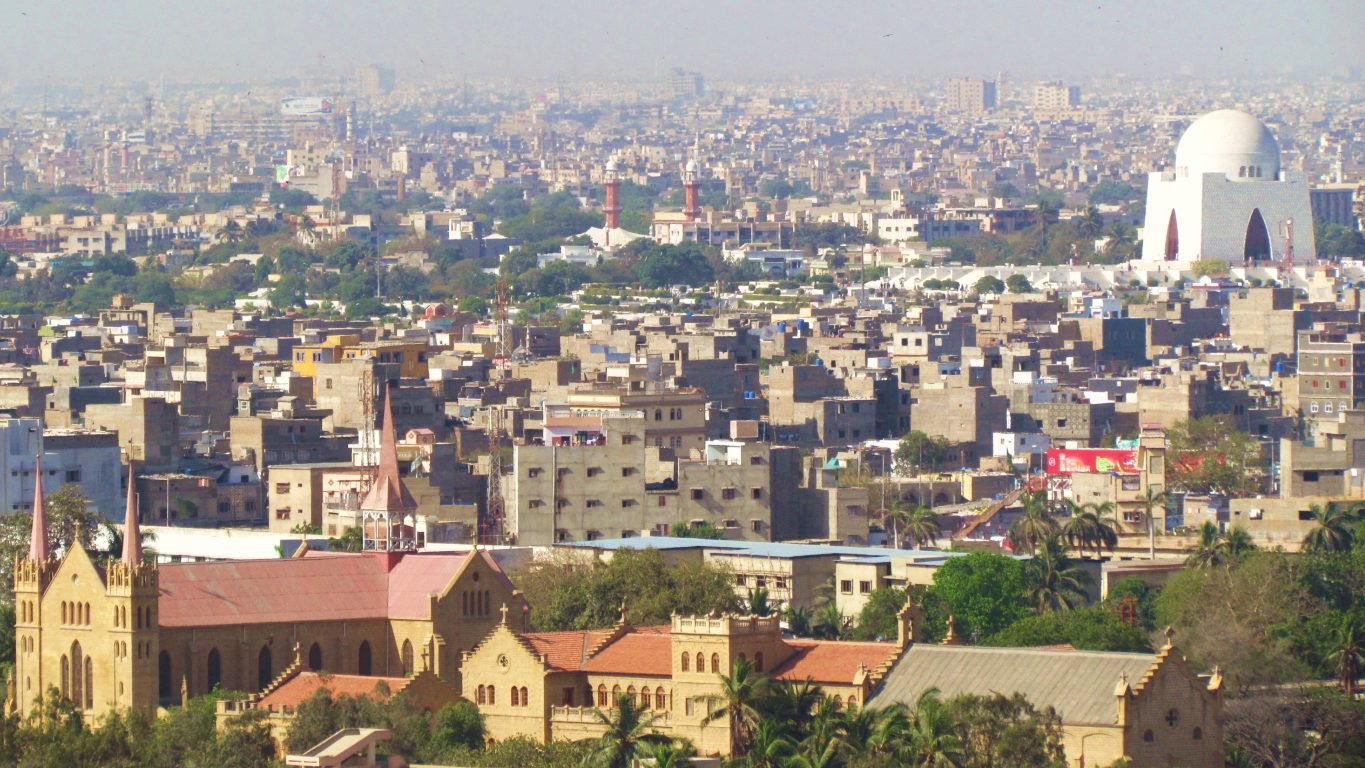
3. Karachi, Pakistan
> City population: 18,000,000
> Country population: 207,862,518
> Pct. of Pakistan’s population: 8.7%
The onetime capital of Pakistan (it was subsequently supplanted by Rawalpindi and then Islamabad), Karachi is the world’s largest majority Muslim city. Its growth rate from 1998 to 2011 was the fastest of any metropolitan region in the world, and its population continues to increase at a rate of about 3% annually. Muslim refugees from Bangladesh, Iran, Myanmar, Uganda, and Central Asia have contributed to the population growth.
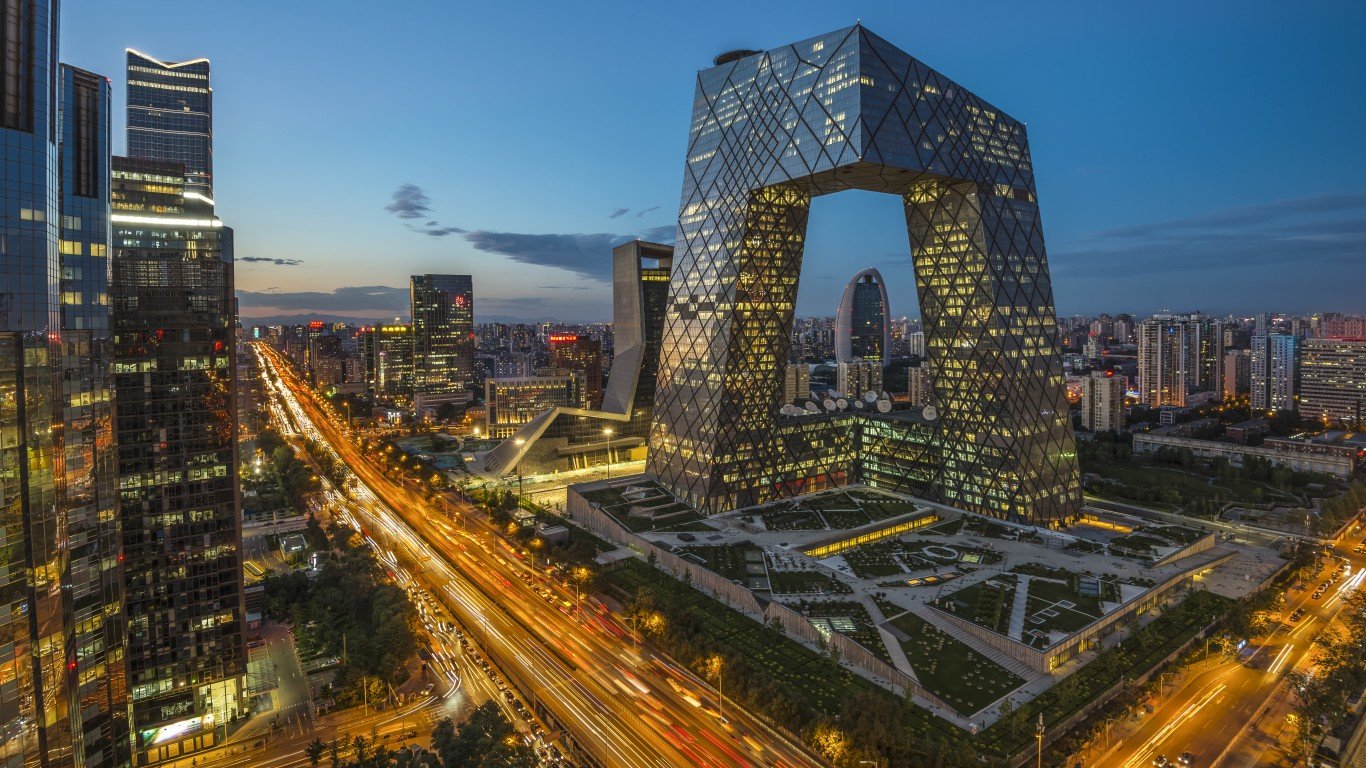
2. Beijing, China
> City population: 18,590,000
> Country population: 1,384,688,986
> Pct. of China’s population: 1.3%
China’s capital city and one of its major economic centers, Beijing boasts an average life expectancy of 81.12 years, higher than that of the European Union on average. Business and educational opportunities continue to draw people to the city, but though China still officially encourages rural populations to relocate to urban areas, Beijing has announced plans to cap its permanent population. This has involved tearing down small shops, shrinking land zoned for construction, and moving schools and some government offices to other cities.
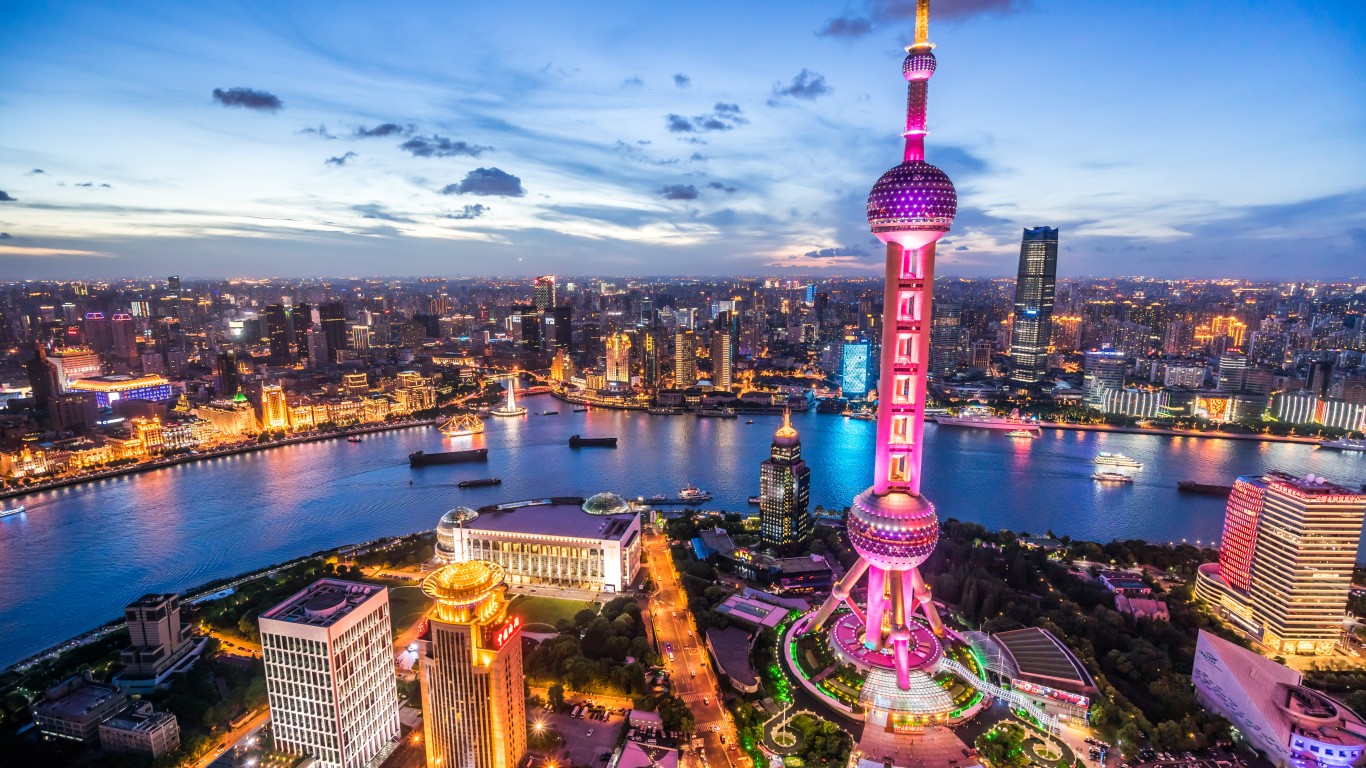
1. Shanghai, China
> City population: 24,153,000
> Country population: 1,384,688,986
> Pct. of China’s population: 1.7%
The world’s most populous city, once known as the “Paris of the East,” Shanghai is considered one of the world’s most cosmopolitan cities and an important financial capital. Long-term migrant workers account for almost 40% of the city’s residents. Though it has a low birth rate — possibly due in part to fallout from China’s one-child policy, in force between 1979 and 2016 — it also has one of the highest life expectancies in the world, at an average of 83 years.
Essential Tips for Investing: Sponsored
A financial advisor can help you understand the advantages and disadvantages of investment properties. Finding a qualified financial advisor doesn’t have to be hard. SmartAsset’s free tool matches you with up to three financial advisors who serve your area, and you can interview your advisor matches at no cost to decide which one is right for you. If you’re ready to find an advisor who can help you achieve your financial goals, get started now.
Investing in real estate can diversify your portfolio. But expanding your horizons may add additional costs. If you’re an investor looking to minimize expenses, consider checking out online brokerages. They often offer low investment fees, helping you maximize your profit.
Thank you for reading! Have some feedback for us?
Contact the 24/7 Wall St. editorial team.

